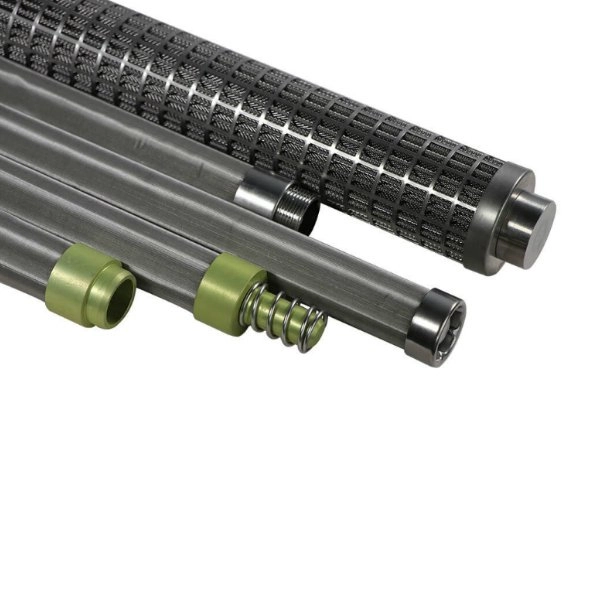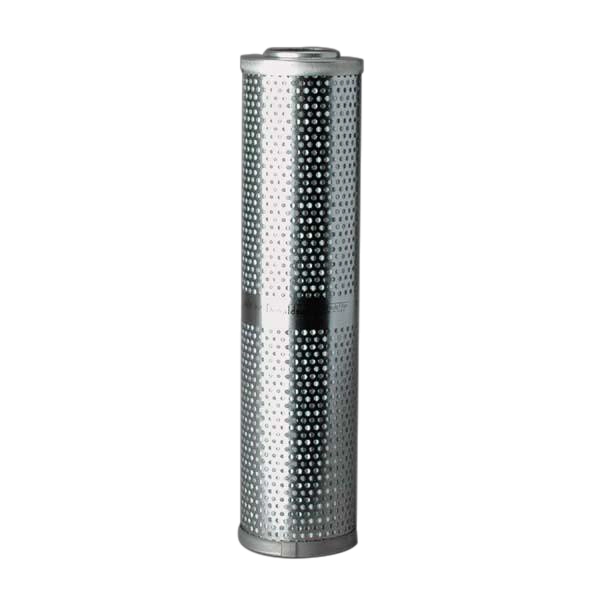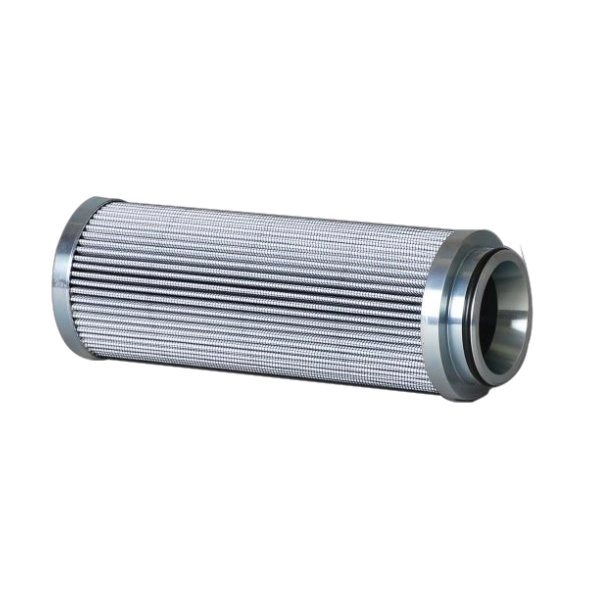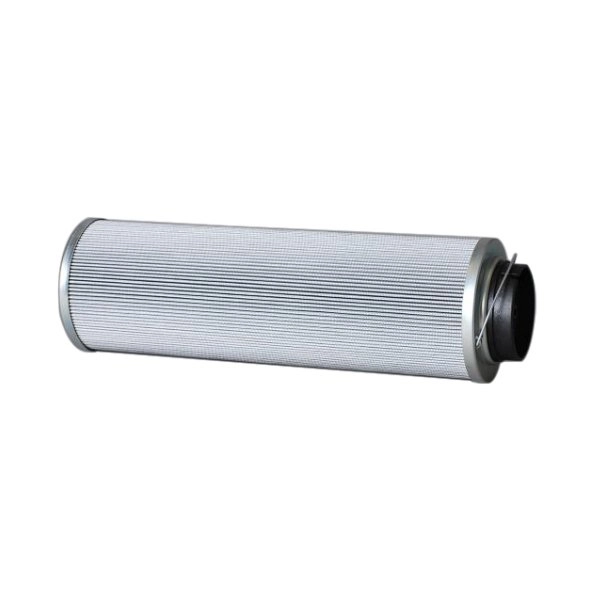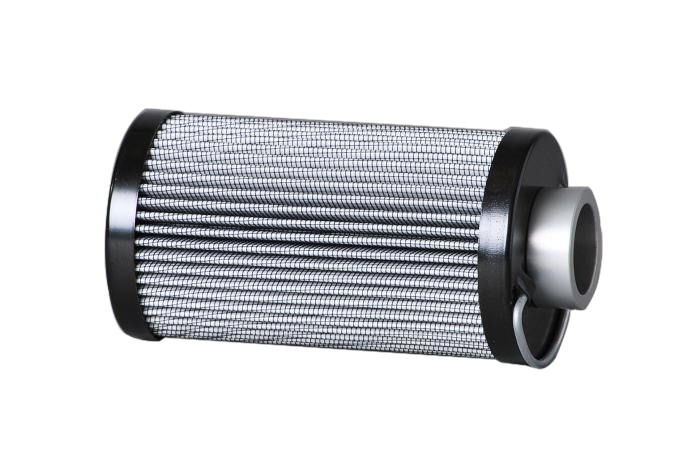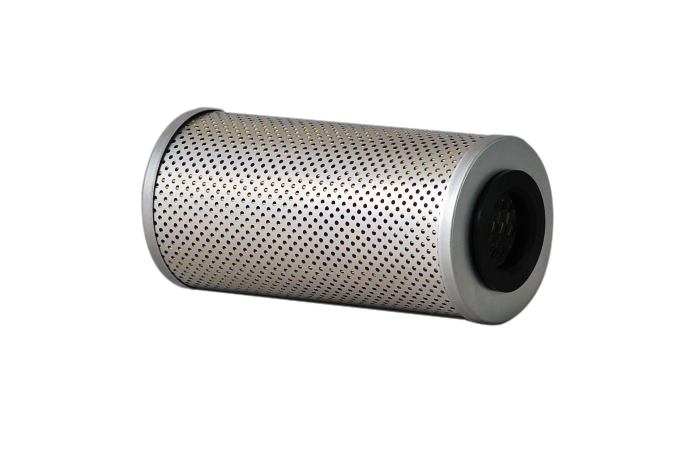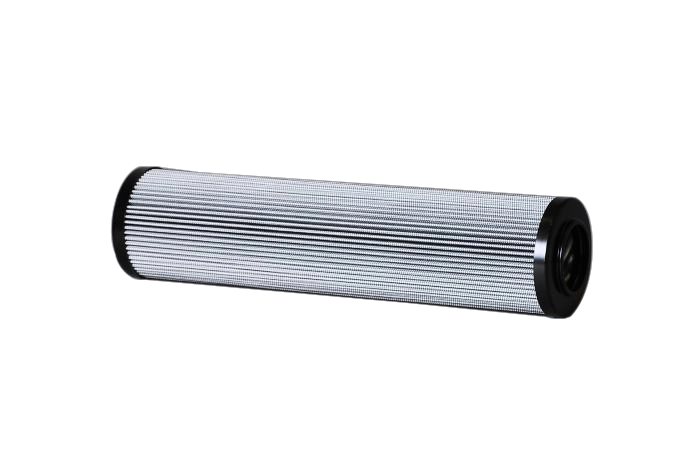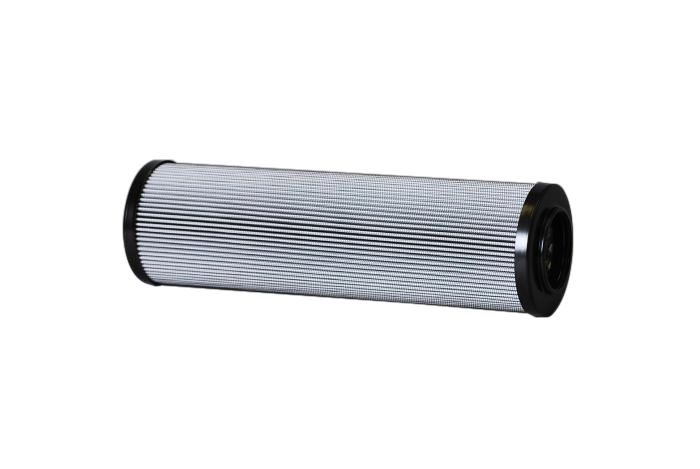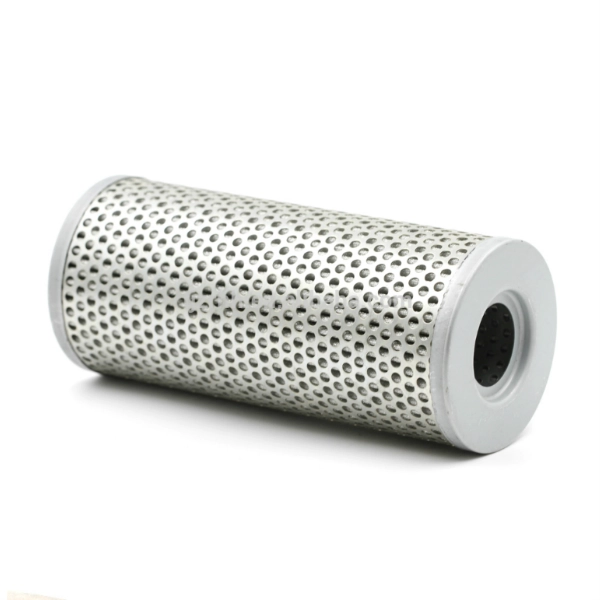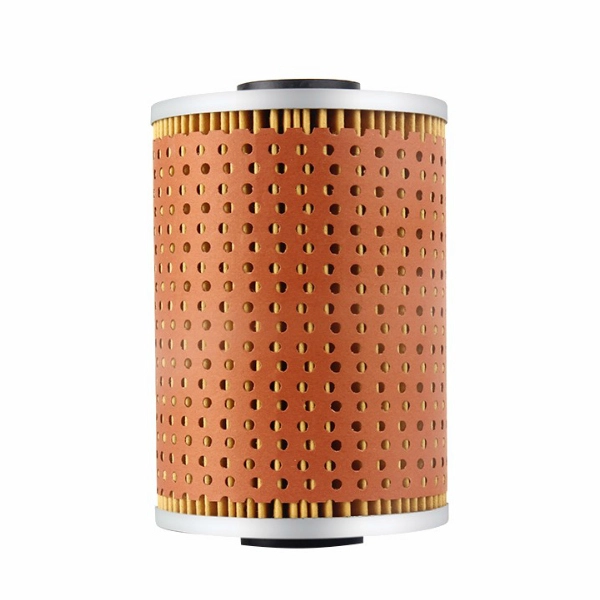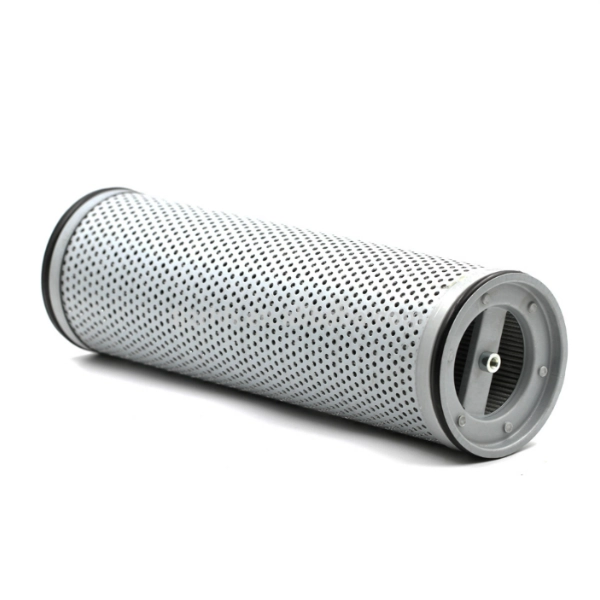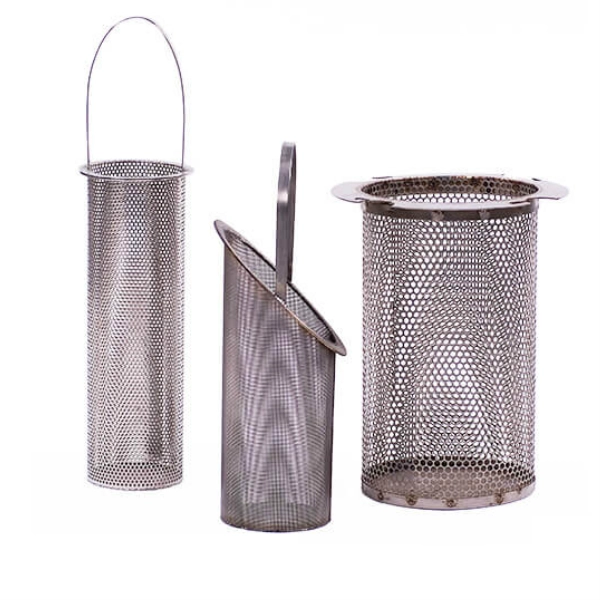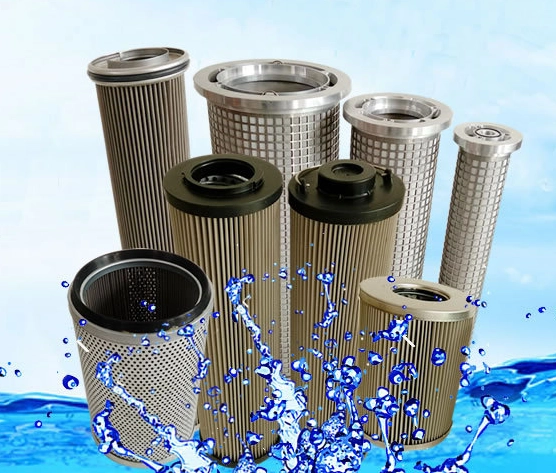Oil Filter Element & Replacement Filter Element
Filson focus on design and manufacture high quality replacement filter elements and custom filter elements over 18 years. We have rich production and marketing experience in handling demanding delivery with flexible custom&replacement filter elements design for a wide variety of industries.
Filson replacement filter elements are 100% interchangeable with over 200 domestic and foreign brands filter elements. We own a complete database of more than 5000 models of replacement filter elements. If you want to save purchase costs without losing the original quality, Filson is your best filtration solution partner.
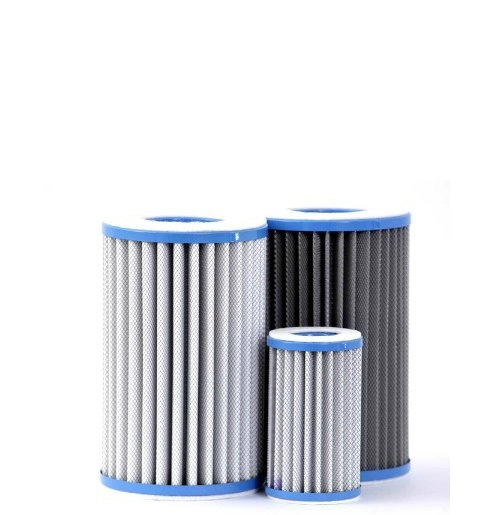
Replacement Filter Element
Filson Oil Filter Element
Related Resource about Oil Filter Element
Your Premier Oil Filter Element Manufacturer
Filson oil filter elements are ideally replacements for many oil filter brand, such as Parker oil filter elements, Pall oil filter elements, Hydac cartridge oil filters, Mahle oil filter elements, Eaton oil filter elements, Argo oil filter elements, MP spin on oil filters, Internoman filter elements, Vickers hydraulic filter elements, Stauff and other brand oil filter elements for low, medium, and high pressure applications.
When replacing another filter brand, Filson oil filter element cross-reference can guide you realize functionally and dimensionally interchangeable to original oil filter elements and help you through performance improvement possibilities.
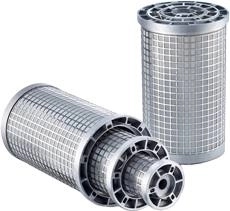
All Filson oil filter elements conform to ISO9001 and CE quality and safety standard.
If you are looking for oil filter element, Fison will be your better choice, send us your inquiry today.
Oil Filter Element: Ultimate Guide to Buying ISO Certified Oil Filter Element
Contaminants in compressor, gear or any hydraulic system oil cause wear and tear of machine parts and components.
It is for this reason that you need high-quality oil filter element, to achieve the desired ISO oil cleanliness standards.
Within the 10 chapters of this guide, I’ll share with you every aspect you must consider when buying your next oil filter element.
Let’s dive right into the subject of this guide.
Chapter 1: What is an Oil Filter Element?
An oil filter element is media whose design is such that it traps all oil contaminants.
These may include impurities such as:
- Paint
- Rust
- Particles
- Water from the oil stream circulation of hydraulic
- Dirt in lubrication even automotive engine system.
Basically, an oil filter element removes all particles and contaminants from circulating within the engine and hydraulic machines.
Therefore, the machine can operate optimally to meet the desired specifications.
What role does an oil filter element play?
First, no machine can operate without hydraulic oil. And that is a fact.
But how do you extend the service life of the operating oils?
Here’s the truth:
You must adopt suitable maintenance, repair or service process.
But more importantly, you should have a way to prevent possible contamination of the oil.
So, the best solution here is to install an ISO certified oil filter element.
It will protect the hydraulic system from any contaminated oil.
The oil filter system will help reduce possible wear and tear of components or parts.
Obviously, it will improve the working condition of the machine.
Below is an image of a simple oil filter element:
Through decades of innovation and improvement in hydraulic equipment, machines, and automotive engines, there have been significant improvements.
This is quite clear when you compare the new and old systems.
These differences are with respect to filter media and construction.
However, the working principles remain the same if not enhanced.
Even with these advancements, you have to appreciate the need to ensure that oil must be clean.
That is the only way to maintain any hydraulic system.
Oil circulation in any pressure system automatically washes some particulates like:
- Metal Particles
- Soot
- Dirt and other oil additive compounds in the oil
Such oil contaminants are a great threat to the system operation if you don’t remove them with an appropriate oil filter.
In locomotives, oil contamination can cause total engine failure.
Generally, to main ISO cleanliness standards of oil, you must invest in modern oil filter elements.
This way, you will save a lot when it comes to the cost of operating hydraulic systems.
How about we look into important ways of optimizing your oil life in the early stages.
How to Maintain Hydraulic Oils
Below are some of the most effective ways of maintaining oil cleanliness in the hydraulic system:
- Use an effective oil analysis method and program
- Identify sources and types of oil contaminants for your machinery
- Reduce or eliminate contamination through thorough housekeeping program
- Carry out filtration before adding oil to the system.
As you can see, your first obligation is to implement an excellent oil analysis and program.
This will help to assess and determine oil contamination levels, that may cause failure in your hydraulic systems.
By adopting this process, you will understand the main sources of oil contamination.
Ultimately, it is easier to come-up will suitable procedures that reduce impurities in the hydraulic system.
Furthermore, to reduce possibilities of oil contamination, you need to check oil storage facilities and prevailing conditions.
You need to talk to an expert who will advise you on possible changes and improvements.
A professional site assessment will have far-reaching benefits such as provide housekeeping and oil systems optimization solution.
Regular oil test for sample analysis must show whether the oil is still suitable for its application or not.
Here, you should consider using a suitable oil filter element for the filtration process.
Of course, if you want to increase the lifespan of your machines, always choose quality oils.
It should go hand in hand with selecting an appropriate oil filter element.
I know at times changing oil regularly can be tiresome.
This can be normal, but you should not make this a habit.
You should take regular oil samples, analyze to check whether the oil filter elements are in good condition or not.
In case there are contaminants in oil after filtration, the best option is to change the oil.
The truth is, cartridge oil filters guarantee better filtration in hydraulic systems.
Of course, this will depend on the quality of the hydraulic filter element.
With that, let me take you a step further to explore another important aspect of the oil filter element.
Chapter 3: Oil Filter Element Technical Data
In this chapter, we are going to define oil filter element terminologies.
I will also discuss vital information about the oil filter element technical data.
By the end of it all, you should be able to make informed decision when setting up oil filtration requirements.
This will basically be a quick guide to choosing an appropriate filter media element.
It will help you in making decision when it comes to optimizing various filtration processes in different types of oils.
Remember:
Both chapters 1 and 2 highlighted the history of oil filter elements.
This chapter will explain industry changes that define and measure filtration process.
It will include technological milestones in establishing new standardized tests for dust, coupled with advances in microscopic particle measurement.
Of course, all these procedures have necessitated industry revolution.

Different types of filters
Don’t worry; I will make everything simple for you to understand.
So, don’t let the few terminologies you will come across in this section confuse you.
Here are important terminologies frequently used in identifying oil filter element properties:
· Contaminant Loading
This refers to the process where the filter element traps and captures particles in the oil stream to a point where all its pores are completely blocked.
As oil flows through the oil filter media contaminants are trapped on it over time.
Fewer open pores are left, which in turn increases the differential pressure across the filter component.
As the filter media continue to load more particulates, the by-pass valve opens to prevent structural failure of the filter element.
Alternatively, the clogged oil filter media can be replaced.
 Clogged Filter Element
Clogged Filter Element
The filter media pore arrangement, shape, size and quantity, determines the life of the oil filter element.
Typically, between cellulose and fiberglass filter media with more or the same filtration rating and thickness – cellulose media have fewer pores as compared to fiberglass.
Therefore, contaminant loading would be quicker in cellulose filter media than in the fiberglass filter media in the same specification.
The design of multi-layer micro-glass fiber media are less likely to be affected contaminant loading.
This is because its upstream port large pores trap larger contaminants.
On the other hand, the downstream part tiny pores capture relatively immense quantity of minute particulates.
·Oil filter Element Material
This is also referred to as filter media material. It is responsible trapping and absorbing moisture content from oil.
Oil filter element materials are made up of varying layers and fabrics.
Lubricant style oil filter
The following are common filter media designed for different oil filter elements:
- Micro-glass (API)
It is usually made of synthetic micro-glass fiber, multi-layer with pleated constructions.
These pre-filters are optimized to provide protection downstream sterile-filters.
Its construction and design aid in removal of minute particles ranging below 1µm.
The pleated borosilicate fiberglass filter material has a high surface area, guaranteeing longer service life.
At the same time they experience little or no pressure change.

Different types of oil filters
It has a consistent minute oil contaminant removal, high flow-rate and greater dirt-holding capacity.
Also, it is capable of removing non-productive and aggregated proteins, colloids, lipids and other impurities.
Features
- It has a wide array of chemical compatibility and accommodates various fluids and application.
- Promote consistency in particle removal due its fixed-pore structure.
- Pose no threat to the environment because it’s non-toxic and biologically inert.
- Sturdy membrane constructions help save energy in high flow rate oil system.
These features make this type of filter media to be used in the beverage industry to help in the purification and clarification.
However, its inert characteristics make it suitable for many applications.
These may include biotechnology, pharmaceuticals, petrochemical, process water, and organic filtration, just to mention a few.
- Micro-glass (WVG)
It is also designed with multiple layers of pleated synthetic micro-glass fiber.
It is best suited for removal of solid contaminants and water out of the oil.
It features micro-glass material together with water absorption layers.
- Micro-glass (VG)
Just like Micro-glass (WVG) and Micro-glass (API), micro-glass (VG) is also constructed in multilayers with pleats of micro-glass fiber.
It has the best fine contaminant retention capacity with a terrific resilience.
Since it has high impurity retention capabilities, this equally enhances the dirt-holding capacity of the oil filter.
Its compactness provides high stability that enables it to operate under different flow rates and pressures.
Last but not least, its high resistance help provide good protection under operation.
- Paper (P)
It incorporates, pleated construction, though if features a single layer with cellulose/organic fiber fleece.
This material is mainly used in flushing operations.
- Stainless Steel Wire Mesh (G)
It features either single or multi-layer, pleated construction-design using stainless steel wire-mesh with varying weaves though determined by its retention ratings.
It is special for trapping and eliminating solid, heavily saturated in fluids.
It’s suitable in pump protection that anticipates minimal pressure drop, hence considerably reduce the risk of cavitation.
This filter media type is compatible with a wide array of fluids.
Oil filter media are classified in two: depth-type and surface media.
- Depth-type
In this class of media, the oil flow is directed into convoluted paths of the filter element.
Depth-type filter media is made and constructed of fiber with innumerable variations in size pores.
The pore maze structure throughout the media helps it capture different sizes of particulates.
Its structural features make it have a high capture rate for smaller impurities.
FILTER MEDIA COMPARISON | |||||
| Filter Material | Capture efficiency | Dirt-holding capacity | Differential pressure | Service life |
Initial cost |
| Fiberglass | High | High | Moderate | High | Moderate to High |
| Cellulose (paper) | Moderate | Moderate | High | Moderate | Low |
| Wire-mesh | Low | Low | Low | Moderate | Moderate to High |
Depth-type media uses only two media types, namely, cellulose and fiberglass materials.
Irregular shape and size of cellulose media makes it have an equally irregular shape as well as a wide range of sizes – while the latter tends to have uniform shape and size man-made fibers.
In addition, fiberglass consistently has thinner circular pores that differentiate its overall performance.
This feature allows fiberglass media to conduct fine filtration as the thinner fiber arrangement remarkably improves dirt-holding capacity along with filtration efficiency.
- Surface-type Media
Unlike depth-type filter media, surface media promotes fluid flow in straight paths through the filter material.
Here, oil, contaminant is trapped along the surface of the filter element as fluid flows.
Woven-wire cloth is a common material used to make surface-type filter media, and produces consistent pore sizes.
But, the contaminant loading process considerably reduces pore size consequently enhancing its ability in capturing smaller particles.
In a nutshell:
Surface-type is not as effective as the depth-type media.
he table below has summary of useful information about media classification:
Filtration type Useful Disadvantages
|
Media-based Filtration—This is the commonest method used in secondary filtration that utilizes either depth or full-flow filtration to remove oil particulate. Indeed, they are easy and simple to operate
|
Full-Flow Media i. Diesel fuel/ fuel oils ii. Gear oils iii. High Viscosity oils iv. Hydraulics v. Oil with additive package vi. Water-based fluids
| i) Cannot remove water ii) Low dirt-holding capacity iii) Not possible to clean below ISO cleanliness levels
|
|
Depth Media i. Diesel fuel/ fuel oil ii. Gear oils iii. Hydraulics iv. Lube oils v. Turbine oils
| i) Cannot filter efficiently past 250F ii) Poor efficiency at 3-5 gpm per element flow rate iii) Large water presences impair filter element functionalities. iv) Cannot accommodate oils with special additives
|
Below is a table indicating different fluids with corresponding suitable filtration media:
Fluid to be filtered Recommended Media
Bio degradable Fluid Synthetic
Coarse Filtration Wire mesh
Diester Synthetic
HWCF (High Water Content Fluid) Synthetic
Petroleum-based Cellulose or Synthetic
Phosphate ester Micro-glass (API)
Water Glycol Micro-glass (API)
Water-Oil Emulsion Synthetic
What follows is another table showing sizes of familiar oil particulates:
Familiar Particulate Micron Sizes
Bacteria 2 µm
Grain of table salt 100 µm
Human hair 80 µm
Lowe Limit of visibility 40 µ
Red Blood cell 8 µm
Silt <5 µm
Talcum powder 10 µm
White blood cell 25 µm
· Filtration Ratings
It is important to understand contamination control to avoid confusing it with other commonly used terms like nominal rating.
A nominal rating is an arbitrary micrometer-value given by different manufacturers.
However, it has little or no useful information about the oil filter element.

Filtration process-Photo Credits: Machinery and Lubrication
Another common industry rating is the absolute rating. It simply means the largest solid particulate size that can pass through the specific filter media.
Still, there is no standard measure for establishing such values.
However, absolute rating can be essential in determining effectiveness of an oil filter element than the nominal rating.
·Beta Rating
It is also known as filtration ratio. This is the common rating term used in oil filter industry.
Beta rating is determined through a string of lab-based MultiPass Tests/ procedures used to evaluate oil filter performance specifications.
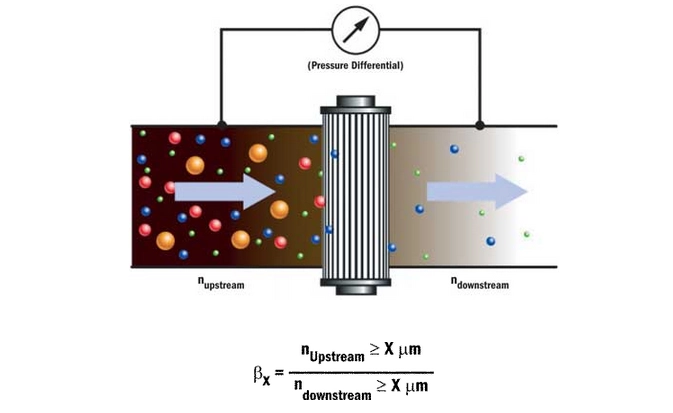
Understanding Filter Beta Ratios – Photo Credits: Machinery and Lubrication
This test is only applicable for oil filter elements with an averagely beta ratio equal to or greater than 75.
Oil filter element manufacturers determine the Beta Ratio value for their products.
The reproducible test results can be used to establish dirt-holding capacity as well as Beta Ratio of hydraulic oil filter element.
Caution should be exercised if you use a beta ratio to differentiate oil filter elements.
This is because it does not put into consideration the actual operation conditions like temperature changes and flow surges.
A Beta Ratio of an oil filter element neither gives:
- Dirt-holding capacity
- Maximum particulate retention level during the filter lifespan nor,
- Indicate performance or stability
Beta Ratio on the other hand, is vital for gauging oil filter element performance.
The test ISO 16889:1999 is a vital mark on oil filters because it measures the efficiency of particulate removal that relates to dirt particle ingression.
In addition to individual manufacturer proprietary tests and ISO 16889:1999, there are several ISO standards that highlight qualities of oil filter elements.
They are as follows:
- ISO 2941 For burst/ collapse pressure rating verification
- ISO 2942 For fabrication integrity verification
- ISO 2943 For fluid material compatibility
- ISO 3723 For testing end load method
- ISO 3724 Determination of resistance to flow fatigue using solid oil contaminants
- ISO 3968 For assessing differential pressure across the filter element versus flow characteristics
·Efficiency
The Beta Ratio of a specific micron rating is used to determine the oil filter element efficiency.
It is mathematically derived through multiplication of the quotient: Beta Ratio minus one and the beta ratio, by 100.
BR—Beta Ratio
Therefore, (BR—1)/BR *100
· Beta Stability
It measures the repeatability of an oil filter element to produce same Beta Ratio under adverse working conditions but at pressure drops.
Having a proper understanding about manufacturers label information on your oil filter element is important – I trust nothing could possibly confuse you next time you visit an oil filter store.
The following is a Beta Ratio and Efficient table showing the general range efficiency and Beta Ratio as ISO 16889 recommends:
BETA RATIOS & EFFICIENCIES | |
| Beta Ratio (At a particular particulate size) | Efficiency (At same particulate size) |
| 1.01 | 1.0% |
| 1.1 | 9.0% |
| 1.5 | 33.3% |
| 2.0 | 50.0% |
| 5.0 | 80.0% |
| 10.0 | 90.0% |
| 20.0 | 95.0% |
| 75.0 | 98.7% |
| 100 | 99.0% |
| 200 | 99.5% |
| 1000 | 99.9% |
Make sure your oil filter element has the manufacturers’ beta ratings describing the efficiency level of the filtrating material.
Normally, it is not possible to establish a direct relationship between the ISO rating scale and beta values.
Therefore, in order to combine the ISO rating and oil filter element performance specification, you need to closely monitor the filter material performance.
At the same time, remove particulates in the interval of 4 µm and 6 µm and 14 µm ranges respectively.
Field monitoring and fluid analysis are the surest methods to come up with such details.
Data from a series of tests would ultimately give a clue on the performance range of an oil filter element.
The actual performance will always vary from one application to another.
·Dirt-Holding Capacity
In other words, it is widely known as the contamination capacity.
In essence, it refers to the highest level of particulates that an oil filter media can bear before affecting its efficiency.
This critical value may vary from one system to another, depending its oil filter element application.
What you ought to understand better is the ISO 16889 Multi Pass Test for evaluating oil filter element performance specification.
Here are graphs that sum up a number of useful tests run on market oil filter elements.
It provides solutions on issues pertaining to oil filter quality and efficiency.

Courtesy of Eaton Filters

Courtesy of Eaton Filters
Hydraulic Systems Sensitivity and Desired Cleanliness Levels
A number of factors are used to determine the cleanliness of fluid in a hydraulic system.
These factors are:
- Filter element micron rating
- Type of particulate
- Distribution in the fluid and particle size
For hydraulic systems to work smoothly while in operation; filtering, cooling lubricants, water-oil emulsions or abrasive particulates, must meet cleanliness level requirements.
A prior fluid analysis will help to determine the best oil filter element for your lubrication and hydraulic system demands.
In order to accurately determine the cleanliness level of a specific fluid, you must use the established standard procedures.
Also, the hydraulic system pressure provides a basis to set the cleanliness class to realize an efficient system.
Below is a pressure based general guideline for the cleanliness level in hydraulic system:
- 35 bar (0-500 psi) —Low pressure
- 35-100 bar (500-1500 psi) —Medium pressure
- 100 bar > (1500 psi and above) —High pressure
System Types Application Case | Required Class according to ISO 4406:99 | Required Class according to NAS 1638 |
| Against fine soiling and gumming up of sensitive systems
| 16/12/8 | 2-3 |
| 17/13/9 | 3-4 | |
| Heavy-duty servo motor systems; high pressure systems with long service life | 19/15/11 | 4-6 |
| Proportional valves; industrial hydraulics with high operating safety | 20/16/13 | 7-8 |
| Mobile hydraulics; common mechanical engineering, medium pressure systems | 22/18/14 | 7-9 |
| Heavy industries; low pressure systems; mobile hydraulics | 23/19/15 | 9-11 |
Chapter 4: Characteristics of Best Oil Filter Element
As you have seen in the earlier chapters, the design of oil filter systems aims at removing any form of contaminants in hydraulic systems.
Even in chapter 2, I went further to discuss the various causes of oil contamination that affect the efficiency of hydraulic systems.
I did mention oil additives, engine combustion by-products, microscopic engine breakaway particle brought about by friction between moving parts etc.

High pressure hydraulic filter
Also, I explored the effects these impurities have in your hydraulic system.
The good news is:
Oil filter elements can help reduce oil contamination as well as a sledge.
This is because oil filter elements are designed to filter all these impurities.
Still, I know you may not wish to hear this – but is the reality:
Even oil filter elements with an outstanding filtration efficiency rating may not guarantee that you’re safe from the effects of particulates in your machine.
Where oil is flowing at high pressure, especially when there are restrictions and clogging due to filter media, oil may bypass the filter.
As a result, dirty oil will flow back to the engine.
So, in this section, you’re going to learn about three main characteristics of oil filter elements.
Let’s dive right in:
1.Low Flow Restriction
In the previous chapter, I mentioned that oil is like blood to an engine while filter element is the liver.
This allusion is because oil and filter element is thought of as being in some way analogous to blood and liver system.
However, the filter element should maintain free flow of oil since it is critical in maintaining a properly functioning hydraulic or lubrication system.
The best oil filter element should offer little or no flow restriction to prevent wear, abrasion, heating due to friction etc.
This is because each hydraulic component depends on an uninterrupted oil circulation for sufficient supply of the system fluid.
Moreover, oil filter must certainly ensure efficient and smooth flow via its media.
2. Efficiency
To keep the wear effect as low as possible, hydraulic fluid should constantly flow throughout the system.
And, to ensure this, you need a highly efficient filter system.
Normally, the efficiency of a filter element is determined by the size and shape of the media pore.
That is, the smaller the pore size of the filter media, the greater efficiencies of the filter in trapping and removing particulates.
This is also referred to as the flow/efficiency compromise, and a good quality filter element must have a great balance between efficiency and flow.
This information should help you estimate life service of your filter element.
3. Filter Capacity
What you must first understand is that filter element is manufactured with a certain maximum capacity to hold contaminants beyond which it becomes obsolete.
At this stage the filter element will hinder and compromise oil flow.
As a result, it will reduce the service lifespan of the filter.
The best oil filter element must have an outstanding dirt-retention capacity to sustain a reliable oil filtration process over a long period.
With that in mind, let’s go a step further and review the various types of hydraulic oil filter element available in the market.
Chapter 5: Different Types of Oil Filter Elements
From chapter 1, it is quite clear how expensive and inefficient contaminated oil can be in the hydraulic system.
It is for this reason that you need to adopt an efficient ISO certified oil filter element.
This will reduce operational costs and possible inefficiencies.
Today, maintenance of clean hydraulic oil is nothing new in a hydraulic system since it has far reaching benefits.
Thus, in fluid-power systems, it is important to have hydraulic oil filter to make it complete.
But how frequently should the filter be changed?
Generally, you should check your filter element from time to time to ensure it is good working condition.
Also, the fact that you make a regular oil change does not mean you are trouble free.
Flushing away old oil is not a way of oil maintenance.
This is because barrel oil is not as clean as you may perceive.
What you should keep in mind is that the major causes of oil contamination come from within the system.
In fact, any new oil can still be re-contaminated in a couple of days.
Now, in this chapter, I am going to discuss the different types of oil filter elements.
Let’s dive right in:
5.1. Hydraulic Oil Filter
Why is hydraulic oil filter so important?
This is because it maintains a system that is contaminant free for smooth machine operation.
In other words, hydraulic oil filter can extend life of your hydraulic oil.
It helps prevent wear and tear of components, while keeping clean oil in circulation.
It is evident that fluid contamination is the major cause of hydraulic system impairment.
Often, component and system failure is inevitable if there is no better fluid conditioning and proper preventive measures.
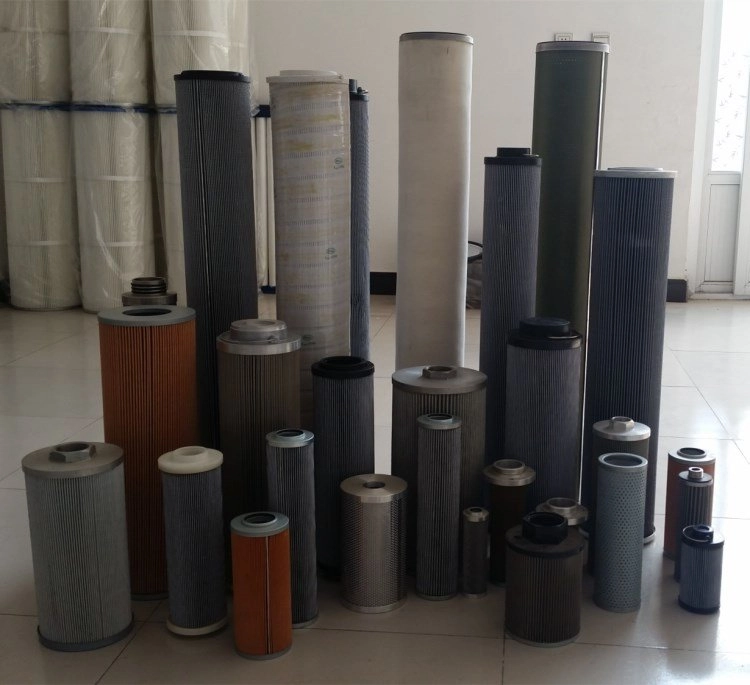
Hydraulic oil filter
Just before we look into hydraulic oil filter as our first item of different types of oil filter element, let’s first understand the functions of hydraulic oil:
Basically, hydraulic oil has four main functions:
- Energy conversion by creating force and motion into pressure for the system.
- Formation of seal by virtue of being between the metal surfaces, this helps in excluding impurities and act as pressure barrier.
- Offers lubrication to the metal surfaces
- Cools the hydraulic components and parts.
Therefore, a hydraulic oil filter is an important component that ensures the above-mentioned functions are met.
In case any of the function fails, your hydraulic system may not function.

Hydraulic filter
Furthermore, sudden and disastrous failure could be imminent.
Such an incidence may mean losses in thousands of dollars for huge businesses.
It is for this reason that you need a hydraulic filter element to reduce possible downtime.
Of course, this also goes hand in hand with adopting a continuous maintenance program.
·Causes of Contamination
Particulates in hydraulic oil exist in the form of air, metal debris, dust, hoses and seals, rubber particles, welding slags, etc.
They all affect the hydraulic system in different ways.
You may be wondering how these contaminants get into a hydraulic system.
Most of them are by-products.
At time of system operation, components and parts wear down debris from the surface system which form part of the hydraulic oil stream.
Seemingly, it is the major cause of oil contamination.
Also, heat generated in the system lead to additive breakdown forming compounds due to corrosion and reaction on the system surface.
Even more impurities are introduced into hydraulic oil.
· Water Contamination in Oil
The saturation level of water varies for each type of oil.
As long as the saturation point is not met, water will always remain completely dissolved in oil.
For hydraulic oils, water saturation level is approximately within the range of 100-1000 parts per million, that is, 0.01%-0.1% at standard conditions.
Increase in temperature makes the saturation level even greater.
Past the saturation point, water tend to be entrained forming large droplets.
If the water contamination level in oil gets to 1%-2%, it directly affects the performance of the hydraulic system.
This is how water affects oil characteristics:
It alters the oil viscosity thus affecting the system optimal performance specifications.
Swift water influx rate equally compromises the system performance.
Also, water vapor pressure is usually higher as compared to most hydrocarbon oils.
Due this fact, most low pressure components and parts experience cavitation that results in further oil contamination.
· Ways to Minimize Contaminations
Always make sure you flush away all contaminants after manufacturing and at the time of assembly before commissioning.
Chemical and solid contaminants result in chemical and mechanical interaction respectively.
At this point, it calls for effective use of reliable hydraulic oil filter to trap and remove contaminants.
This helps avoid harming the system and prevent it from seizing.
·Elimination Practices
To prevent entry of oil contaminants into the hydraulic system, you should use an appropriate hydraulic oil filter that fits your application.
Moreover, routine oil maintenance to monitor the oil conditions and properties is important.
This will help reduce the threat of potential damage caused by oil particulates.
Apart from using appropriate oil filters, there are other measures that can improve hydraulic system performance.
They include the following:
- Use return-line diffusers to baffle the oil reservoir to curb churning that causes entry of air into the oil stream.
- Install hydraulic oil filter media that has almost 100% efficiency and designed with breather.
- Make sure all fittings are well tightened.
- Carry out a test flush to confirm its filtration mechanism.
- Conduct oil pre-filter before feeding it into the system.
- Carefully inspect all the filters.
- Do a complete overhaul of filter element before opening the by-pass valves to avoid running the hydraulic unit without the oil.
- Take good care when replacing hydraulic oil filters and other replaced components.
- Regularly analyze oil to check if there are any changes in oil conditions.
·Removal Process
Contaminants in hydraulic oil can be controlled and reduced by outgoing, settling, separation/filtration and oil replacement.
Settling and outgassing are natural occurring processes – to enhance their effect, you must control the system design.
On the other hand, the latter pair requires human involvement in maintenance and repair activities or at the design stages.
Contaminants must remain more buoyant in oil and slightly less dense than oil to directly flow towards the hydraulic oil filter for separation.
Otherwise, it will greatly affect the rate of removing particulates in the oil.
Dense particles interfere with the situation and settling could be a possibly better method than filtration.
For a fact, natural removal mechanism is not quite effective – it rarely reduces the extent of contamination.
Remember, replacing the oil permanently may not address such detrimental problems.
But proper use and maintenance of hydraulic oil filter can tremendously extend the life of your hydraulic system.
5.2. Lube Oil Filter
The lube oil filter plays a pivotal role in the engine oil system.
This is because it filters all the lube oil circulating through the engine and other moving parts.
Lube oil acts as ‘blood life’ of the engine while the lube oil filter is the liver.
It helps in sweeping away foreign debris, wear materials, cooling the engine parts and lubrication of the moving components.
You should use lube oil filter to remove contaminants that are generated from within the system.
This saves engines from wear due to abrasion.
Normally, this abrasion is due to solid contaminants which rapidly build up from engine operations.
If you become careless in handling oil, soon maintenance costs can be very expensive.
If you carry out a comprehensive maintenance, repair and service, then you will have to spend a lot more on oil.
Using lube oil filter is one convenient method of prolonging life of your engine oil.
At the same time, you will reduce the effect of wear-causing solid impurities.
Of course, you will only achieve this through filtration.
Having a robust filtration system means you will be getting the value for your money.
Through efficient use of lube oil filter, you will be able to effectively eliminate particulates responsible for wear impact in your engine.
Consequently, the life of the engine is also extended, and over time oil change reduces.
This somewhat helps you save on money set aside for maintenance, more uptime and in business means more revenue.
Soot generated from the fuel combustion process in the engine leads to the formation of the sludge in lube oil.
Soot can also cause disastrous wear to your engine, if it not adequately addressed.
But lube oil filter incorporates a superior filtration mechanism that target wear-causing particles, that is, soot.
In chapter 3, we dealt with details on technical data concerning oil filter element.
Now it is upon you to choose from a vast variety of lube oil filters in the market.
Using the ISO data, knowledge on filter media and Beta Rating will help you to choose an appropriate filter.
Always focus on choosing a quality lube oil filter that matches or rather, exceeds ordinary oil filters.
Remember to use one that fits your application to get desirable results.
5.3. High Pressure Oil Filter
The engines burn gasoline to produce energy, on the other hand, oil offers protection.
In fact, oil protects the actual workings of your engine.
Therefore, when there is little or no oil in the engine, it is likely to overheat.
Overheating is due to lack of lubrication between moving parts and insufficient cooling process in the engine.
Ultimately, this will cause a wear down of the engine.
If you notice that your engine has low-energy, oil-pressure, it implies that there is inadequate supply of lubrication oil.
This can cause severe internal damages and can turn to be catastrophic.
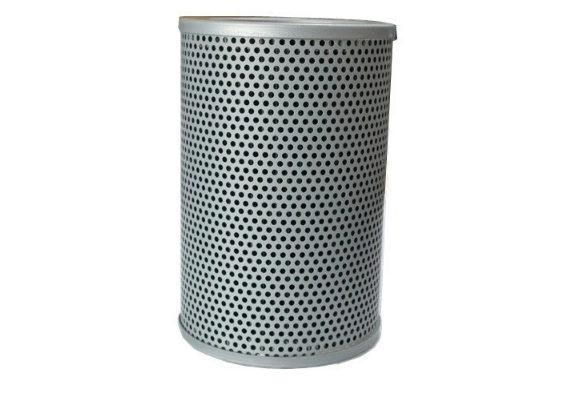
High pressure oil filter
Why don’t we look at the various reasons that cause low oil pressure?
You should keep these in mind:
·Engine Wear
Just like blood flows through its vessels, an oil system circulation is designed within the engine block to allow smooth oil flow.
The oil circulation system runs through the cam bearings and crankshaft bearings of an automobile.
However, because of frequent wear down, the clearances make the paths wider.
As a result, oil flows with low restrictiveness, eventually reducing oil pressure.
·Oil Viscosity
This refers to the thickness of the engine oil.
Higher viscosity implies that the oil will be thicker.
Consequently, it will have a slow flow rate when you compare it with that of low viscosity.
This is will definitely have an impact on oil pressure at different times of the year because the viscosity depends on temperature.
Also, high viscosity oil will hinder rapid buildup of oil pressure.
·Filter Impairment
High pressure oil filter plays a greater role in regulating appropriate oil pressure in the system.
However, if the filter media get clogged it affects the pressure altogether.
High pressure, oil filters are specifically designed with pressure relief-valve that helps to maintain desirable pressure.
Nonetheless, if the valve is impaired, oil will freely flow into the engine which will reduce oil pressure.
·Damaged Oil Pressure Gauge
Modern engines are highly sophisticated.
Most manufacturers install oil pressure gauge in their automobiles to enable the owner to monitor oil pressure at any given time.
It is possible for you to be unaware of a decrease in oil pressure, if the oil pressure gauge is damaged.
· Insufficient Oil in the Engine
This is the biggest cause of oil pressure problems.
Most people remember to fuel, but not to refill the oil reservoirs or more often check on their levels.
You can easily sort out this problem by refilling the oil.
Luckily, there are a number of ways to correct oil pressure problems.
Since it is majorly caused by insufficient oil, it is wise to have regular check on its level in order to maintain the required threshold.

High pressure oil filter
Another solution could be opting for low viscous oil; in temperate regions have it filled just before the winter season.
If you have no idea how to go about it kindly seek an expert’s advice.
A professional mechanic should satisfactorily address this issue.
If your high pressure oil filter is damaged, ensure you know its ratings before buying one.
Alternatively, you can contact your engine manufacturer for further assistance.
5.4. High Flow Oil Filter
High flow oil filter has a variety of applications.
They mainly include hydraulic systems with high flow rates.
Such systems require oils with long service span.
This type of oil filter element is capable of delivering high flow rate while ensuring extensive particulate filtration more reliably.
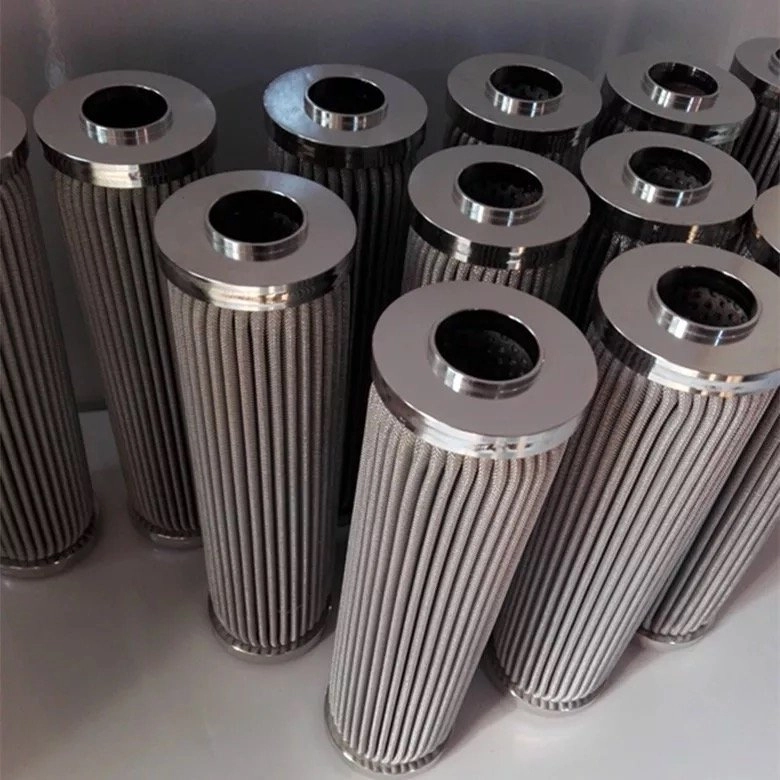
High Flow Oil Filter
Its unique construction allows high flow rate.
This allows the filter media to accommodate the flow with ease.
With an exceptionally high dirt-holding capacity, it extends the life of operating fluid and reduces unplanned downtime.
High flow oil filter has a strong and compact design.
This is critical when it comes to withstanding vigorous oil stream in the media.
The best part:
Most of them feature innovative technologies that optimize the filtration process.
Therefore, if you’re looking forward to reduce maintenance and repair costs, then you need to go for the high flow oil filter.
High flow oil filter has its pore structure uniquely made of radial pleat fiberglass, polypropylene or polyester-sulfone membrane.
This helps in uniform oil distribution across the media.
The fluid flow in the filter media remains entirely uniform across the surface.
This maintains the general flow rate due to the same dimensions of length and width on both sides of the filter material.
Moreover, this increases the amount of fluid flow in the media with a notably excellent dirt retention capacity.
The uniform pore in the media offers precise and reliable oil quality.
However, for the high flow oil filter to resiliently function irrespective of high differential pressure across the filter element,
there must be:
- Have an elaborately designed downstream outlet
- Well-propped upstream of the hydraulic system
The layers in between the filter element must be an open channel to lower oil flow restriction when the system is online.
5.5. Basket Filter Element
The Basket Oil filter is also referred to as basket strainer.
This filter element is designed with a handle though occasionally others lack it, and its base is flat and porous.
The construction of the filter element assumes the shape of a basket hence the name basket filter.
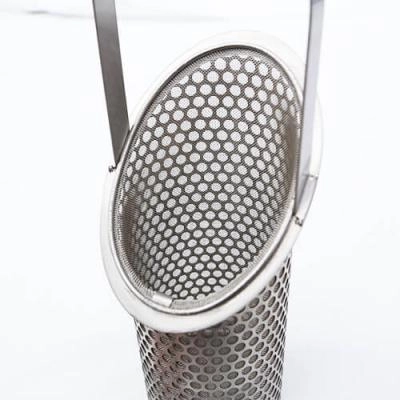
Basket Filter Cartridge
Mostly, the basket filter element material is made of stainless-steel perforate-mesh, stainless-steel wire-mesh cloth, stainless-steel weaving mesh, etc.
Its housing is also manufactured from carbon steel, cast iron, stainless-steel, and other materials.
The holes in the perforated mesh are usually made in staggered-pattern to increase surface area for filtration process of the basket element.
This filter element is divided into two:
- Slated-basket filter
- Standard-basket filter from a layer to multi-layers
The basket filter element can accommodate and filter a wide range of fluids to eliminate contaminants.
However, the filter suitably handles coarse filtration as the particulates captured are easily removed and the filter element cleaned.
The basket filter element is designed with different micron sizes and levels of mesh depending on type of application.
This filter element is also available in customized orders as requested at time of manufacturing.
Normally, basket filter is one of the most accurate among the filter mesh elements.
Once you place it in the flow path, unfiltered oil enters the housing and goes down through it.
Solid impurities are either retained inside or pass the flat bottom section of the filter element.
It depends on the pore size and shape.
The captured solids are cleaned away when the basket strainer is pulled out.
Chapter 6: How to Select Proper Oil Filter Element for Your System
In chapter 3, you saw some of the important technical information that you can use to differentiate oil filter elements.
In this chapter, you are going to learn how to select proper oil filter element if need be.
Choosing the best oil filter element for your application should be an activity of great importance.
The truth is:
The market is flooded with similar and confusing products.
So you must pay attention to specific details.
This way, you will spot various differences in:
- Gasket or thread size
- Filter material
- Note filter element ratings, etc.
To avoid any possible confusion, you must review the manufacturer’s manual or consult an expert on this.
Such documents contain a lot of information that will help you know more about a specific filter element before deciding to purchase it.
Using a wrong filter can cause further losses as oil may leak out, poor filter fitting could cause more impurities infiltration.
Either of the above could lead to fatal system damage or failure.
Let’s have a quick overview of factors you must consider when choosing a correct oil filter element:
Factors to Consider when Picking Cartridge Oil Filters
Below are some of the main factors you should consider before you buy a cartridge oil filter:
· Dirt-Holding Capacity (Contamination)
It refers to the maximum quantity of contaminants the filter media can bear before compromising its filtration efficiency.
This is also determined by type and size of your hydraulic system.
The manufacturer should provide information about the dirt holding capacity of the filter.
With this, you can know the service lifespan of the filter element before its efficiency is compromised.
All these play an integral role when choosing a suitable filter element.
For instance, a car uses a cartridge oil filter different from that of another hydraulic system.
This is because they have completely different functions.
Furthermore, these engines run on different quantity of oil, thus, their oil filters will be of varying efficiencies.
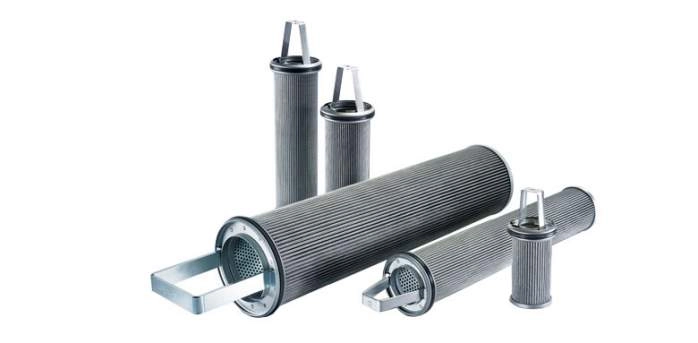
Basket Filter Element
Dirt-holding capacity is often overlooked, but it is an important aspect when selecting an appropriate element of your application.
Therefore, when you want to buy a new filter element find out about the DHC of your old element.
It forms the basis of what filter element when replacing these filtration accessories.
·Environment/system
It is imperative to consider the characteristics of the environment and system where the cartridge oil filters will be installed.
This should include contamination expectations, location, vibration, flow rates, etc.
·Collapse Rating
ISO 2941/ANSI B93.25 shows the differential pressure across the filter media that causes the element to fail, and that value is the collapse rating.
A filter element designed with a bypass-valve should have a collapsing rating at least twice stronger than a full-flow bypass-valve differential pressure across the filter media.
The collapse rating of filter media in its housing should be slightly more or less as the value of the system relief-valve upstream.
Of course, this is a situation without bypass valve.
This is because when the element reaches or exceeds its DHC, particulate clogs are common.
As a result, it will affect the hydraulic systems downstream.
This results in chocking due to contamination of sensitive components.
·Cartridge Oil Filter Integrity
The structural integrity of the filter refers to the ability of filter to prevent the flow of oil via unfiltered passage.
It would be wise to use test records from the International Organization for Standardization (ISO).
This information will help you to establish:
- End load
- Flow fatigue
- Fabrication integrity
- Material compatibility.
These test results can reveal a number of defects such as:
- End cap
- Filter high temperature effects
- Poor seam seals, and many more.
·Particle Capture-efficiency
This defines the whole filtration process happening within the filter media.
It is basically the extraction and retention of contaminant from the circulating oil.
Pressure Loss: It is the loss of overall differential-pressure in the system due to filter installation.
The filtering material surface area and porosity are the main cause of pressure loss.
· Oil Type
Knowing the type of oil will help you make a decision on the type of filter element you should go for.
Different fluids exhibit varying chemical and physical properties.
For instance, viscosity, effects of temperature on fluid flow, fluid compatibility, etc.
Hence, it will be easier to understand your system filter requirements when you have such vital data about oil.
·Pressure Drop
You ought to know and understand the effect of the pressure drop across the cartridge and the element.
This is very vital during sizing of filters.
Elements that offer low pressure drop though at high Beta efficiency are essentially better.
You can’t even compare them with elements with high initial differential pressure at same Beta efficiency.
The bottom line:
By considering all these aspects, you will obviously get the best oil filter element that will meet your expectations.
Chapter 7: How to Replace Oil Filter Elements: The Step-by-step Guide
The process of oil filter element replacement can cause unprecedented contamination ingression.
Therefore, you need to be cautious here.
In this chapter, I am going to show you how to replace an oil filter element.
I will take you through a step-by-step process.
You’ll also learn how to minimize particulate ingression while carrying out the oil filter change over.
Now, let’s check out the proper ways of replacing the oil filter element:
Step 1:
First, begin by running the hydraulic system or engine because the relatively warm oil drains away a little bit faster than a cold one.
Though be sure to run the system for a couple of minutes to get the oil warm enough.
Trust me:
You would not want to get the system actively running because the oil becomes extremely hot to safely drain it away.
Step 2:
After stopping the hydraulic system, go ahead and disable all air handling system units that may be directed towards the oil filter location.
Step 3:
Wipe out any dirt on the filter head using a clean cloth rag.
This is to minimize particulate ingression while opening the oil filter assembly.
If you choose to use liquid to clean up the assembly, avoid using solvent as it poses a contamination threat in the hydraulic fluid system.
Or else, it is prudent to use new hydraulic fluid afterwards.
Step 4:
It is wise to have proper ventilation before draining the oil filter.
Try using an outside-to-inside flow arrangement.
It will prevent system fluid contamination’s on the assembly when lifting the filter element from the hydraulic fluid.
If this is proving to be a daunting task, you may as well drain out the fluid into a bucket and later add it to the quarantine tank.
Step 5:
When the quarantine tank reaches two thirds full, use a filter cart to cycle it to remove particulates.
However, to be certain send a sample out to verify if its conditions and properties meet your system specification requirements.
Normally, this is in terms of viscosity or additives.
If the test is positive, you may get the fluid back using a clean filter cart.
Remember not to place the filter lids on the floor since it may collect more contaminants.
Place it on a clean lint-free cloth, with the interior side facing up and put another clean lint-free sheath on top.
Step 6:
Remove the new oil filter element from its packaging.
Always make sure you open it from the bottom to keep the filter media covered to protect it from environmental contamination.
It is true most contamination cannot be seen with our naked eyes.
If your gloves or hands have dirt, then a huge amount of dirt would contaminate the filter media.
Step 7:
This is the moment of setting up the new filter element in place.
If that particular replacement is done from the top, you may need to push it down.
Then gently turn the element properly towards the bottom nipple.
Again, you can conduct all these processes using your gloves/hands, only if there are clean.
In one way or another, still there will be contamination, but at least when clean, the amount of contamination transferred is immensely minimized.
Step 8:
Inspect the top cover/ lid to confirm whether it is in the right shape to be re-used.
If the lid is in good condition, use it to re-seal the newly placed filter element.
Before moving to the next step re-check the whole new assembly unit if correctly re-installed.
Step 9:
Finally, go back to step 2 and reconnect the air purge system because it is necessary in bringing the whole hydraulic system back online.
This video is courtesy of CAT.
The following are reasons that will force you to have an oil filter element overhaul due to filter failures:
· Channeling
At high-differential pressures, the prevailing force makes the filter media pores to enlarge.
It may be to an extent that compromises the filtration mechanism of the filter in overall.
This consequently affects the contaminant capture efficiency.
It is because previously trapped particulates will pass through the enlarged paths rendering the oil filter element useless.
·Fatigue Cracks
During cyclic-flow conditions, it is possible for cracks to form in the filter media, which will breach the filtration process thus allowing free flow of unfiltered oil.
· Media Migration
Over time, the media fiber gets deteriorated in the process it ingests new contaminants into the fluid system.
The main cause of this problem may emanate from poor element placement.
Alternatively, it may be due to lid covering during installation or even shambolic fitting of the filter.
Vibration generated from the fluid flow along with extremely high-differential pressure can cause disintegration of the filter media.
·Plugging
When the dirt-holding capacity is exceeded, the filter media may somehow get plugged or sometimes resulted by excessive coolant, moisture or oxidative additive.
Chapter 8: Oil Filter Element Application Guide
This chapter will focus on various applications of the oil filter element in different fields.
In the previous chapters, you saw how oil filter element protects hydraulic system from contaminants that can cause wear.
Generally, it helps improve performance of the machine.
It doesn’t matter whether your system uses convectional or synthetic hydraulic fluids.
This is because there are quite a number of appropriate oil filter element that will serve your purpose.
As long as you have fitted the right filter element, it will efficiently filter out oil particulates.
Besides, it will remove over saturated moisture from fluid circulation.
With that, let’s go straight to the main applications of oil filter elements:
· Provide Power Generation with Contamination Solutions
In order to have a more reliable and sustainable power plant operation, there is need to adapt and implement a contamination control system.
That is, you need to provide a clean environment for fluids right from its arrival to waste disposal.
To achieve this, you may conduct various procedures such as:
- Quick survey of both hydraulic and lubrication systems
- Identify baseline for achieving ultimate fluid filtration

High flow Filter
All new fluids are pre-filtered upon arrival also during transfer while reservoirs and tanks are not left out but properly sealed.
This is an attempt to ensure contamination free hydraulic system.
Fitting lubrication and hydraulic systems with appropriate oil filter element will prevent any possible contamination.
Here, the design of hydraulic and lube oil filters depend on advanced technology.
Therefore, they can meet the right filtration specifications.
Useful in Lumber Industry
Normally, one of the main causes of unexpected downtime of total failure of hydraulic systems in lumber industry is oil contamination.
Furthermore, the environment is highly susceptible to fluid contamination, keeping in mind the kind of activities going on.
Of course, all these will result in unnecessary penalties and expenses.
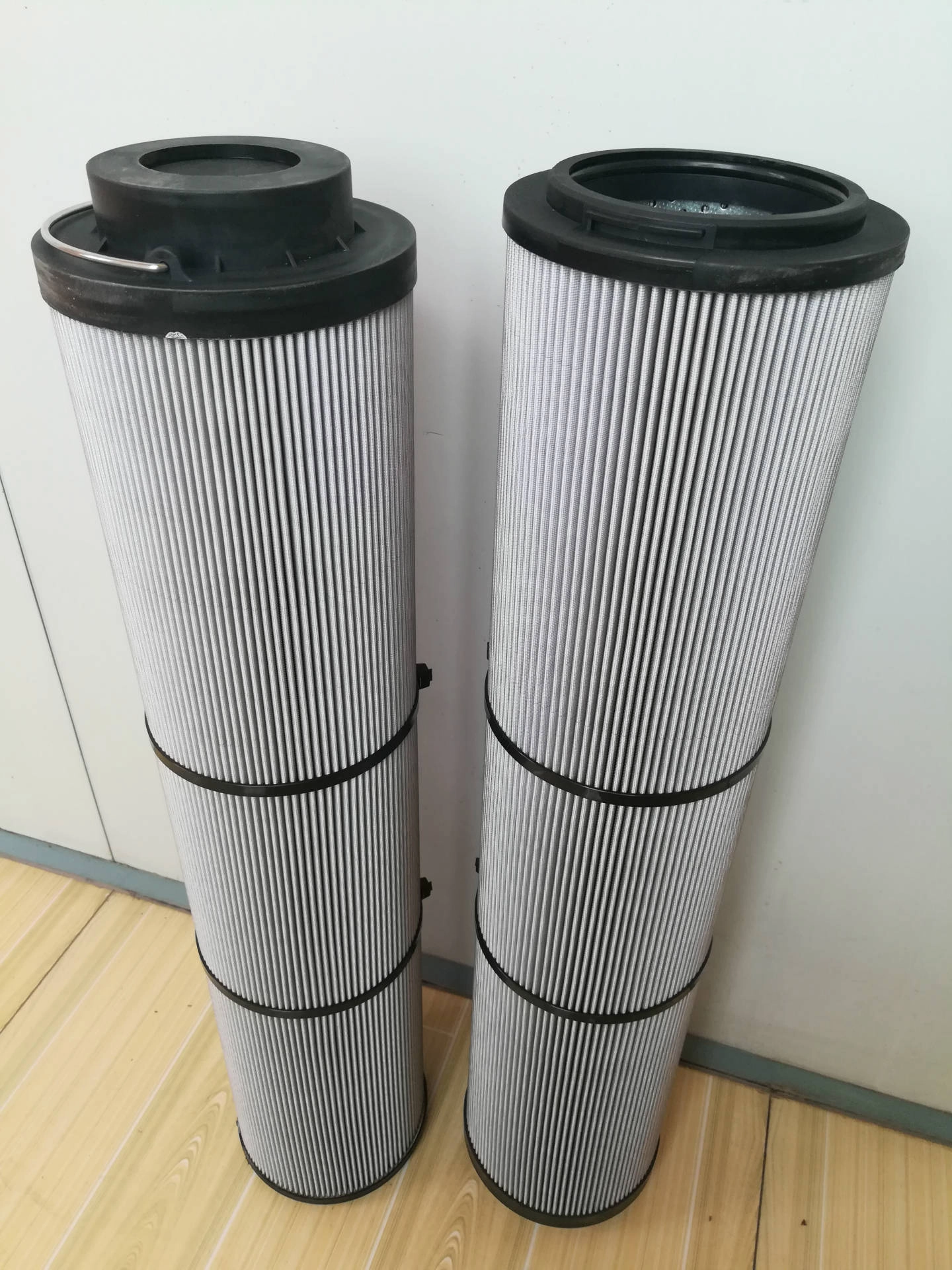
High Flow Filter
By choosing a suitable oil filter element, you can operate machines in the lumber industry without unnecessary incurring expenses.
Therefore, the oil filter element is as important as the filtration process.
This is because without such hydraulic filters the equipment would still fail in a short while.
Improving Performance of Rolling-Mill Lube-Oil and extend Component Life
In the steel industry, hydraulic machineries position and set up work pieces for various processing.
The hydraulic oil reservoir is coupled with a high pressure pump which cascades oil down to the steel working-equipment whenever required.
The process demands constant supplying and throttling of oil.
One major challenge that hinders smooth operation is significantly fine contaminants and water.
And this arises from stress exerted on the surface of the system and inherent fluid impurities.
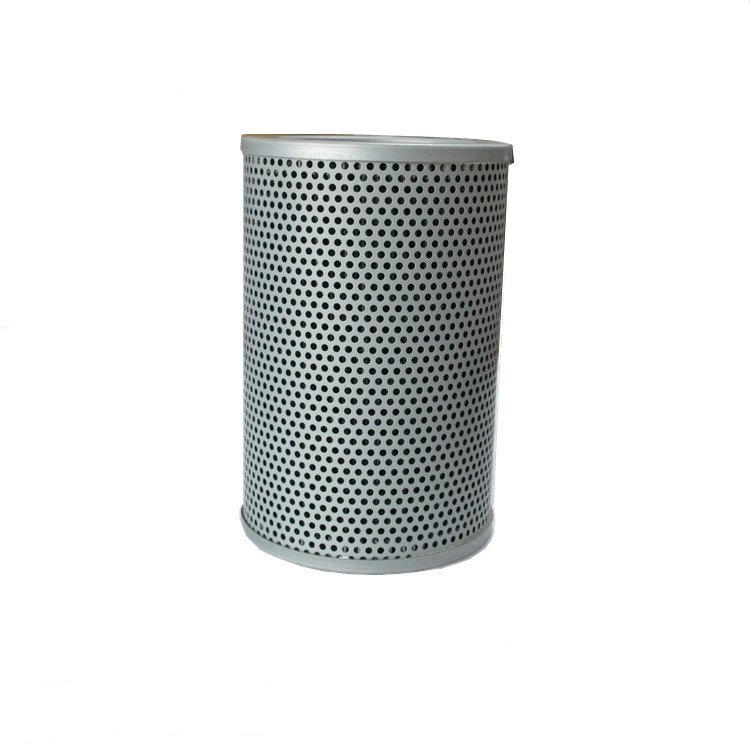
Hydraulic filter element with aluminum casing
Such particulates affect the chemical and physical properties of the hydraulic fluid.
If contamination saturates the hydraulic fluid then failure of critical components like hydraulic control valves, positioners, etc., is imminent.
This reduces service life of such oils.
Old days practices of documentation and use of antiquated-centrifuge equipment still do not stop short the life of the bearing.
But, do you remember of what we discussed about water saturation in oil?
That is why the above strategies cannot sufficiently address the contamination issue.
This means the lubrication oil deserves a further filtration mechanism to at least restore its general properties.
Now, the oil filter element with water absorbent material will help in removing water from the contaminated oil.
Any oil flowing into the bearing and other moving parts of the machine would certainly provide good lubrication and promote plant efficiency and reliability.
·Automotive oil Filtration
Let me take you down the history lane:
Earlier, some trucks were designed and manufactured with dis-mountable cartridge shells and fitted with a replaceable oil filter element.
When overhauling the filter, one used to:
- Take off the housing shell
- Get rid of the filtering element
- Clean the shell
- Insert a new filter material before re-mounting the engine components.
Then came the spin-on filters that had both the filter media and cartridge intact.
It’s used filtering material was discarded and a new one screwed on during the oil system maintenance process.
Presently, modern engines and hydraulic systems, have embraced this technology.
The idea of dis-mountable cartridge housing and replaceable filter media come with a number of advantages.
First, it has opened up market for different parts of cartridge oil filters.
Rather than purchasing a whole unit, you can just buy a new filter media to replace instead.
Unlike yesteryear’s vehicles, modern hydraulic systems require fewer oil changes.
In fact, adaptation and utilization of replaceable non-metallic cartridge filters are eco-friendly.
They do not cause environmental degradation like the spin-on filters.
· Improving reliability of hydraulic pumps
If hydraulic tanks are left open it becomes prone to contamination.
This contributes to dirt and dust infiltration into the hydraulic fluids.
When the hydraulic systems are put online, it means contaminants can result to wear down effect on the surface of the pipes.
This will obviously be a great threat to delicate components downstream.
Over time, hydraulic pump can break-down due to the effects of fluid contaminants.
To prevent constant particulate contamination, hydraulic pumps are properly sealed though left installed with breathers that incorporate air filter.
This implies ingression of contaminants from the environment will also be taken care of.
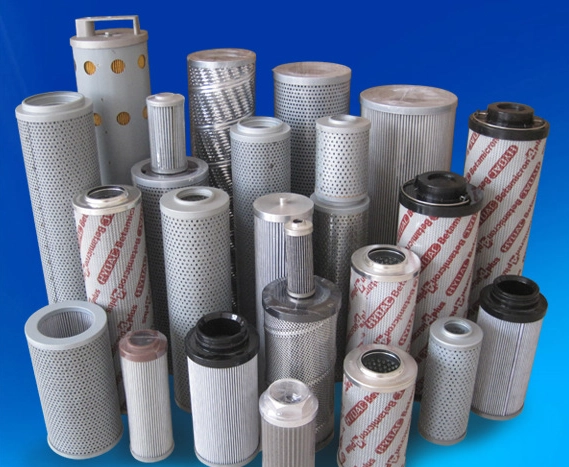
Filter Element
High pressure hydraulic oil filters can be installed on the filtration system as a more efficient contaminant remover.
Apart from filtering out oil particulates, the hydraulic filter element also provides protection to other fragile components of the system.
· Corrosion Control in Petro-Chemical Industry
From crude oil, innumerable products can be made out of it through the application of some complex procedures.
Just from the raw form, intermediate, by-products to end products – you must eliminate a number of contaminants.
Such contaminants are salts, water, traces of metals and gases.
In some production stages, contaminants must be released, but high concentration can result to corrosion of critical system components.
In particular, extremely sensitive areas like the control rooms, process-control system or switcher can be in great danger.
Any corrosion damage to the electrical components and other technical devices will affect the performance of the whole process.

Aluminum hydraulic filter
This industry has adopted modern customized filtration solutions.
They incorporate inert oil filter elements, which meet special performance needs.
The use of different oil filter elements has ensured reliable protection for manufacturing equipment and machines from corrosion with reactive contaminants.
· Filtration in Refineries
Oil and gas industry has over time improved and innovated environment-friendly hydraulic oil filter elements.
Extraction of most products in refineries such:
- Diesel
- Fuel oil
- Gasoline
- Jet fuel
- Kerosene
- Liquefied petroleum gas (LPG), etc.
All require a contamination free environment.
These products are usually stored in a huge container vessels for storage before supplying via a pipeline network or by road transport.
Normally, at these storage facilities, the products are infiltrated with impurities and other solid debris like dirt, dust and rust.
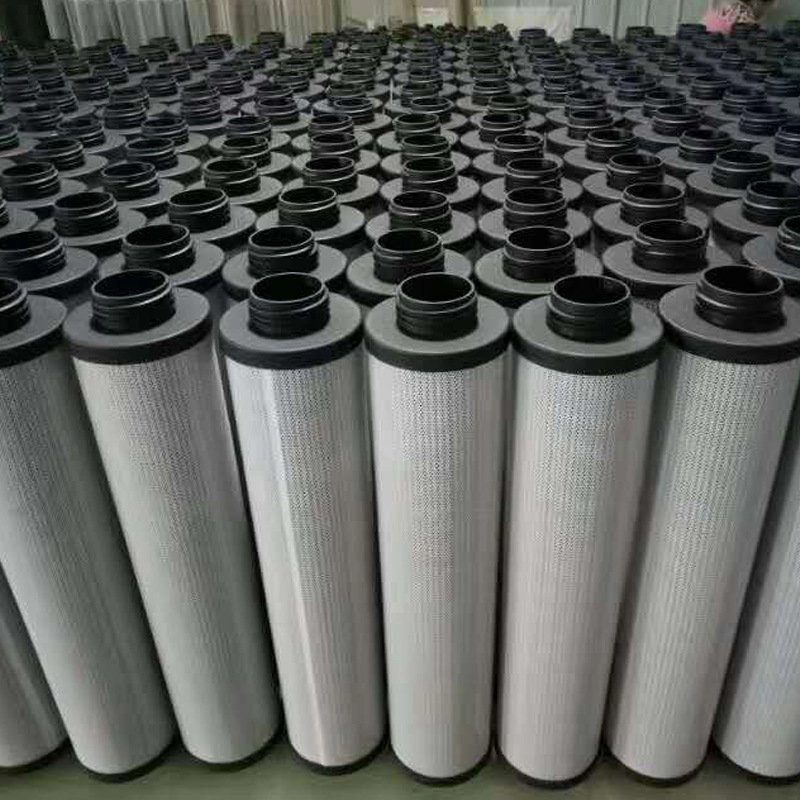
Different sizes types of hydraulic filtration systems
Most of these small particles can cause damage at upstream points of distributions and if delivered to consumers.
Therefore, it is important to install and effective filter element.
Also, it is for this reason that refineries have developed offline filtration systems.
For example, they coalesce and re-filter their products to capture and remove particulates prior to delivery.
The bottom line:
Filtration efficiency that each filter element guarantees implies higher-quality end-products that have less environmental impacts.
· Beverage Filtration Solutions
Ever increasing consumers’ demands for high quality bottled beverages, led to the implementation of various filtration systems.
The truth is:
Filtration process prior to bottling has revolutionized most beverage companies.
During the production stage, filtration process helps to get rid of product-spoiling micro-organisms.
Remember, all these filtration processes do not affect the taste of these beverages.
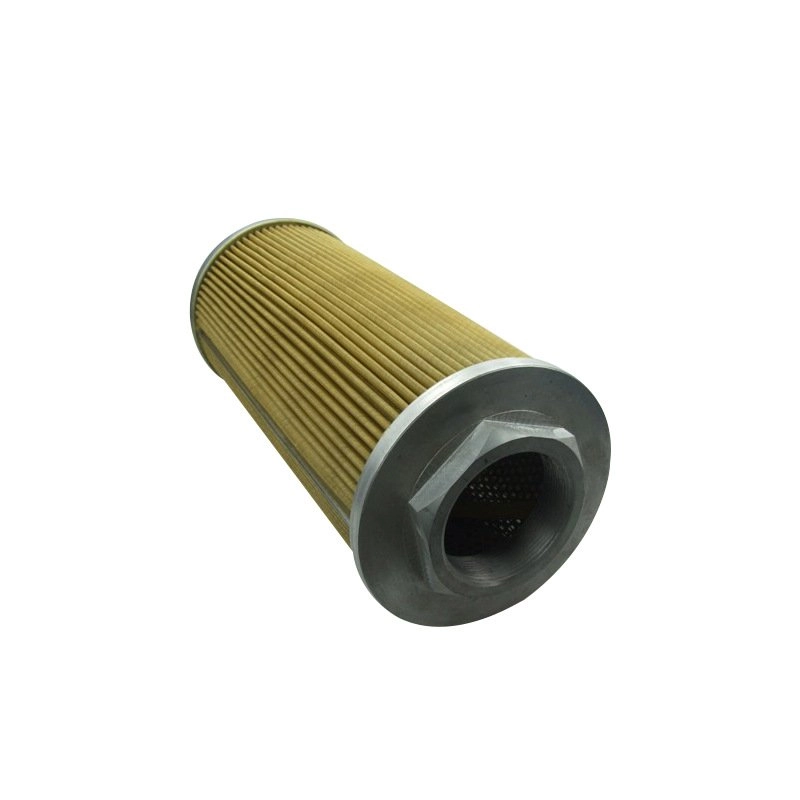
Hydraulic filtration system in beverage industry
They use modern filter elements that remove particles as well as micro-organisms.
Moreover, in bottling stage, both fully-automated and manually-operated machines are installed with filtration systems, mostly in series.
The filter housings are fitted with cartridge filter elements for pre-filtration and final-filtration steps.
The end filtration step help prevents further contamination of the end-product during bottling exercise.
· Oral Dosage Filtration in Pharmaceutical Industry
The manufacturing process of oral-dosage products such as cough medicines, intestinal medicines, mouthwashes, etc. depend on uncontaminated hydraulic system.
Therefore, it is important to adopt an affective oral dosage filtration in the pharmaceutical industry.
The purpose of filtration is to capture and eliminate smaller or visible particulate that rather leaves the product with unacceptable appeal and taste to customers.
The commonest filter elements used in filtration processes of oral dosage are mainly pleated and depth porous polyethylene cartridges.
They have a filtration rating ranging from 1-40 microns.
Chapter 9: Oil Filter Cross Reference Chart
In this second last chapter, I am going to show you how to find suitable oil filter element replacement.
Also, you will understand the importance of oil filter cross reference chart.
Oil filter cross reference chart is in fact a very useful tool for oil filter element buyers as well as oil selling businesses.
Being involved with hydraulic systems and other industrial machineries, a cross reference chart can be a vitally essential and sensitive resource.
So, why do you need this chart anyway?
· Helps you to Make Accurate Decision when Buying a Hydraulic Filter Element
It is mandatory to have an oil filter cross reference chart when working with various equipment and machines.
The chart helps you to take decisive steps before making a purchase.
These readily available charts are very instrumental when it comes to quality evaluation.
Anyway, what am I trying to say here?
Oil filter cross reference charts give you a glimpse of the bigger picture in overall.
These cross reference charts offer chains of premium prospects together with vast customization choices that are available at competitive rates.
· Allows for Easier Access to Information about Oil Filter Elements
By going keenly through the charts, you are able to identify superior oil filter elements.
This can make a huge difference for your hydraulic or lubrication system.
You will find information such as:
- Excellent efficiency
- Dirt-holding capacity
- Beta ratings are usually highlighted on the charts.
For instance, if you see an oil filter with poor efficiency, it implies that significant quantities of oil contaminants would fill it quickly.
As a result, it will stop oil filtration allowing flow of unfiltered oil to critical components and parts.
In a short while, this could render your oil filter element useless.
But because you have adequate knowledge, it becomes easier to understand the consequences that such filter elements could have in your hydraulic system.
Therefore, oil filter cross reference charts can help you to accordingly prioritize oil filter element choices.
This can be in terms of superiority efficiencies like other popular filters by referring to such critical technical data about filters.
However, it would not be wise to depend on a single characteristic because while other filters will have an outstanding efficiency rating they may exhibit flaws on some features.
A filter can have an exemplary efficiency but may not be suitable in line of your application.
Depending on your environment and system requirement, the choice of your oil filter should match application requirements.
· A Vital Resource when Budgeting
The added advantage of having multiple references is that you are in a position to know the average market prices of the oil filter element.
As a result, it is possible to make an approximation of the projected maintenance and repair costs.
In the end, this will assist you generate an actual budget estimation.

Example of a reference chart
By accessing newer or updated reference charts, your filter manufacturer can help to begin upgrading your filtration system.
That is, you will use newer technologically advanced filter elements.
The cross reference chart must have details on the oil filter element components, for example:
- Component model number
- Product description
- Filter media type
- Filtration efficiency
- Beta rating, etc.
Depending on different cross reference chart, you should be able find a simple guide to help you to go about the chart and satisfactorily understand it.
Since different manufacturers offer their charts, we are going to name a couple of leading oil filter manufacturers.
You should look at cross reference charts for:
- FilSon Filters
- Concept-Filter
- Donaldson Filtration solutions
- Fram
- Baldwin
- Boegger
- Pentair Industrial
- Eaton
- HIFI Filter
- Hydac
Most manufacturers usually combine other competitors’ brands into their cross reference chart publication.
This gives customers the power to choose and compare, among other premium oil filter element brands.
Generally, similar oil filter elements are put in the same row for easy identification.
They can even serve as direct replacements.
For instance, if there are five oil filter brands listed in a cell, it implies that they have similar features.
But, their order in the cell may also mean a totally different thing altogether. T
his can be in terms of capacity, efficiency, design, etc.
Online Oil Filter Cross Reference
The global oil filter manufacturers have made an effort to simplify search and reference of oil filter products.
They do this by creating websites with reference materials for any interested person to access for free.
Follow the oil filter cross reference chart website and it will lead you to a page like the one you can see below:
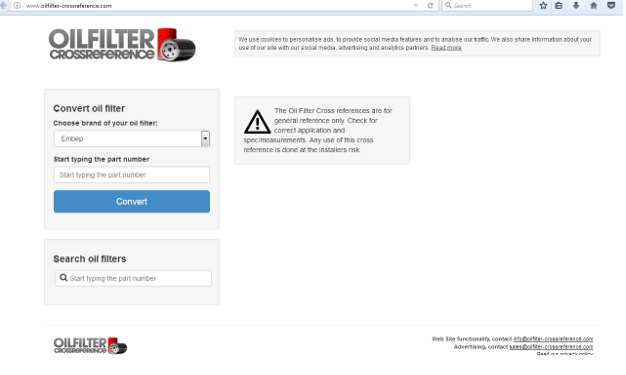
Example of cross reference chart
On the left hand side of the page there is a dialogue box where you choose the brand of your oil filter. I will use ‘Donaldson’ brand.
In the second part, type in the part number of the particular oil filter element. Here, we will use this detail ‘P171505’.

If you now press enter, the website will search for the possible types of the oil filter replacements.
Or rather convert to the likely possible replacement.
This is what it will give you as results:

As you can see in the image, the website will search all available matching oil filters and list them with their respective model details.
This is a kind of information that you should write before going into the market to look for a replacement.
With all the above alternatives, you will definitely get an appropriate oil filter element for your application.
Alternatively, at the bottom left there is another dialogue box where you key in the oil filter part number.
Place the cursor outside the search box and it will display the brand name for that specific part number.
But if the brand of your oil filter is not featured, I regret this type of oil filter reference will not be of great help to you.
Chapter 10: FilSon Oil Filter Element
In this section, I will take you through some of leading oil filter elements from FilSon Filters.
With this information, I am sure you can get the best oil filter element for your system.
FilSon Filters designs and manufactures excellent oil filter elements for most hydraulic systems.
They are accessories you can count on for a “zero” leakage and contamination free hydraulic system.

I am sure throughout this guide; you have learnt how devastating contaminants can be to your hydraulic system.
In most cases, they lead to expensive downtime or total failure of the machine.
This can either be through wear or changing chemical composition of the hydraulic oil.
FilSon oil filter elements are known for being sturdy, robust design, improved reliability and efficiency in hydraulic systems.
Unlike oil filter products from other manufacturers’, FilSon oil filter element utilizes par excellence materials along with filter media to make their great products.
Sophistication of filter material is an added advantage for the FilSon oil filter element.
This is because it effectively captures oil contaminants thereby increasing cleanliness and system efficiency.
Moreover, the FilSon cartridge oil filter element has thermosetting-adhesive seals that hold firmly the filtration media.
It maintains a consistent and dependable filtration process.
FilSon cartridge oil filters must pass vigorous industrial laboratory standard tests – so far, it is one of the few companies that meet the industry standards in hydraulic filter systems.
By adopting state-of-the-art design and technology, FilSon Filters provide engine protection and promote efficiency of the oil filter element.
At FilSon Filters, you are assured of high quality filter elements that match your budget.
Let’s begin by looking at:
· FilSon Hydraulic Oil Filter Elements:
Hydraulic oil filter offers high performance and pressure stability, extend fluid service life and many more.
It has an effective filtration mechanism that can isolate the contaminants from the operating liquid.
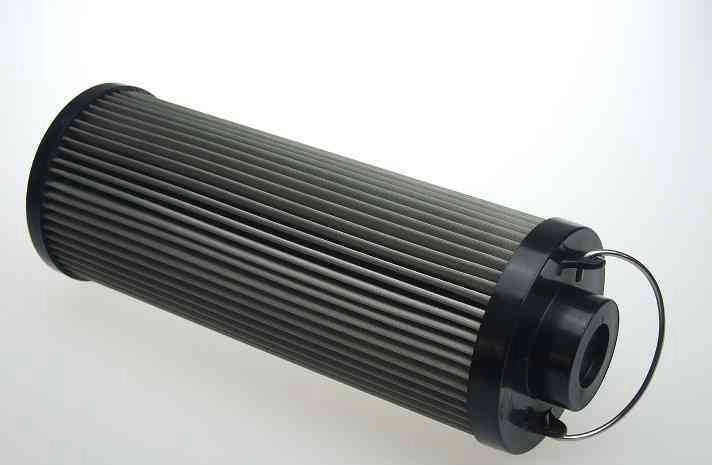
FilSon Hydraulic Filter Element
Achieving an acceptable cleanliness level of your system is possible through the implementation of an effective hydraulic filtration process.
And at FilSon Filters you are sure of getting a variety of unparalleled products that can do that!
Below is an outline of various hydraulic oil filter elements available:
· FilSon Stainless Hydraulic Oil Filter
It is essentially a popular brand from FilSon Filters due to its structural integrity and long life service.
In general, FilSon Stainless Hydraulic Oil Filter is efficient in capturing fluid impurities that helps to enhance reliability of hydraulic system.
However, the filter media and application helps to determine the number of layers as well as mesh and wire-mesh counts during the design stage.
For instance, stainless hydraulic oil filter has a stainless steel micronic material.
Its refined filtration-accuracy and design application guarantees long service life.
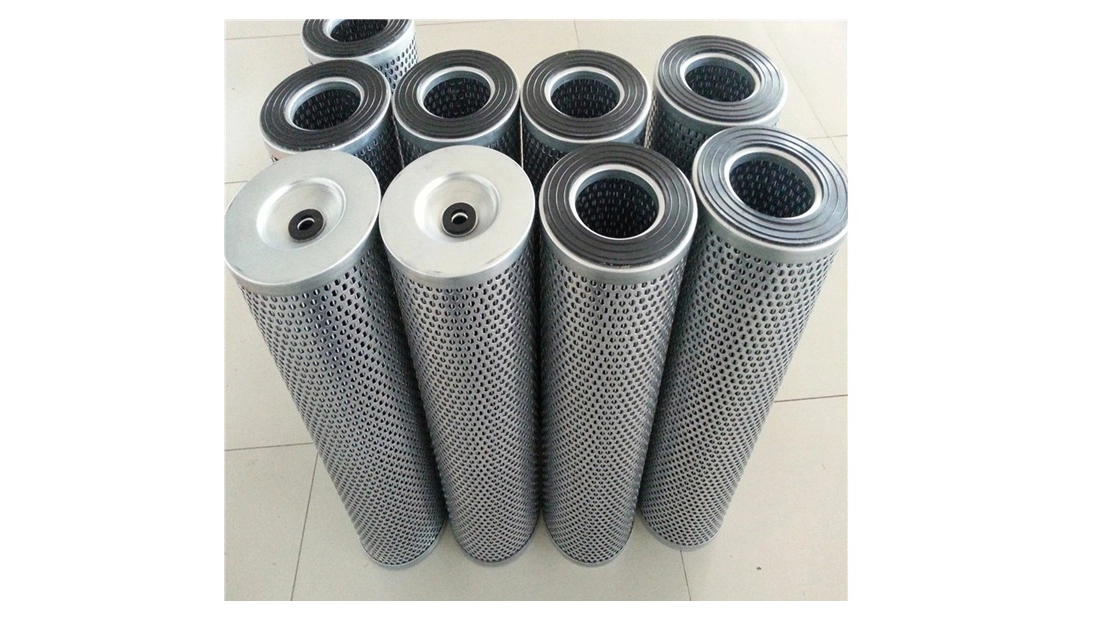
Stainless steel hydraulic filter
Features
- The filter material is designed for long service lifespan to increase cleaning cycle.
- Its design accommodates a wide range of humidity and temperatures.
- Strong filter media contribute to the overall integrity of the filter and outstanding filtration efficiency.
Application
It is useful in the industrial filtration of crude oil, evaporation, distillation, industrial lubrication and many more.
In addition, it comes in hand during:
- Water treatment
- High temperature gas handling
- Protecting the oil pumpfrom blockages
Besides, you can use it in extremely harsh conditions as well as in offshore technology.
· FilSon Fiber–glass Hydraulic Oil Filter
This hydraulic oil filter product has a synthetic fiberglass filter material.
With fiberglass media spectacularly outmatching the cellulose media because the fiber can be designed and made thinner in a more uniform pattern.

FilSon Fiber glass Hydraulic Oil Filter
This enhances its filtration process with the ability to trap smaller impurities.
Also, it has multi-layers of varying quality.
This creates an extremely effective medium with a high dirt-holding capacity.
It can be used to filter hydraulic oil and lubrication system in various applications.
· Mesh Hydraulic Oil Filter
FilSon Mesh Hydraulic Oil Filter consists of epoxy-coated wire-mesh, stainless steel of different filtration ratings:
100 mesh can attain up to 150 µm filtration level
200 mesh can attain up to 74 µm filtration level
325 mesh can attain up to 44 µm filtration level
The above information clearly demonstrates how an increase in mesh improves filtration mechanism of the filter media.
It can be deployed to capture harsh and large particulates that could possibly destroy an ordinary hydraulic oil filter.
Therefore, its design enables smooth filtration of viscous fluids.
· Spin-on Hydraulic Oil Filter
FilSon pin-on hydraulic oil filter is designed with mountable head, which can easily fit in a hydraulic piping.
The main requirement of design and application is to achieve the highest level of cleanliness.
The filter media are contained within its cartridge housing, which prevents leakage during fluid operation.
FilSon spin-on hydraulic oil filter is economically and effectively designed for low-pressure line in hydraulic systems.
Remember, its cartridge fits in a wide mixture of filtration processes.
It is also compatible with various types of media, that is, emulsion, fuel, glycol water, synthetic fluids and oils.
Its cartridge can withstand extreme conditions such as considerable pressure range of 12-35 bars and temperature range of -250C-1100C.
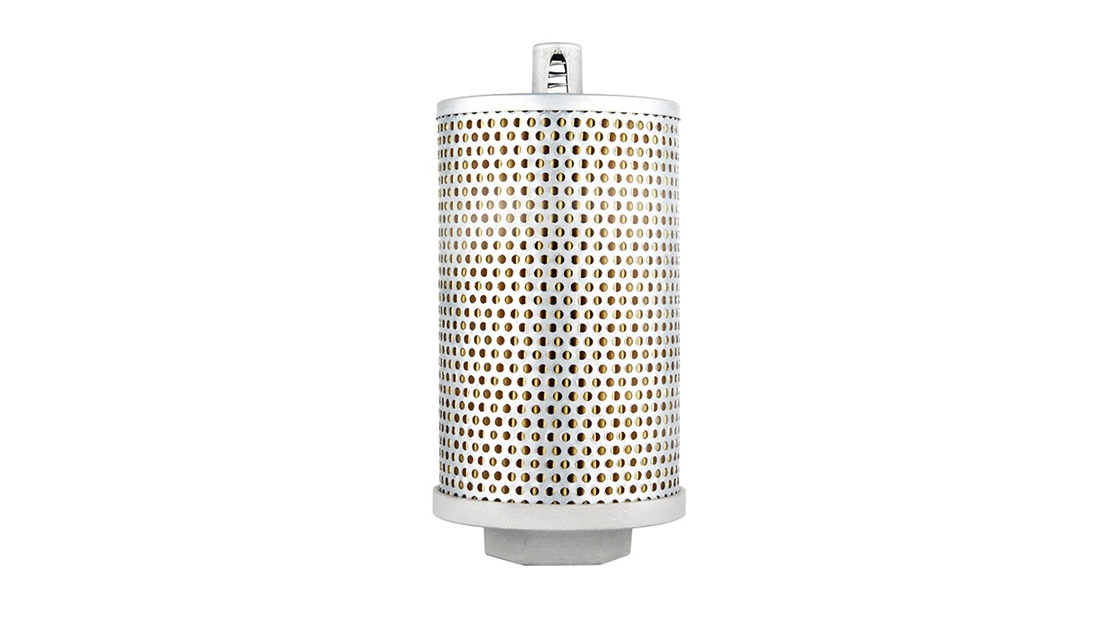 Spin on hydraulic oil filter
Spin on hydraulic oil filter
· FilSon Ultra-Filter
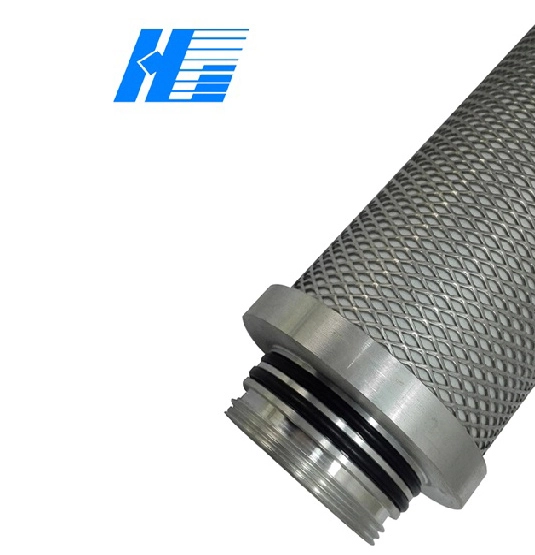
FilSon Ultra Filter
Ultra-filter hydraulic oil filter is one of the leading FilSon Filters hydraulic brands.
Its filter material is made of a sintered-poly-ethylene material and designed with an absolute contaminant retention-rate.
It has a pleated surface that increases surface area for fluid flow and filtration process.
Plus, it combines various particulate removal methods like direct impact, filtration mechanism and sieve effect to trap different contaminant sizes.
Normally, the least is about 25 microns.
FilSon ultra-filter has a high dirt retention capacity because of the uniform pore size ingrained in the filter media.
· Oil Gas Water Filter
FilSon oil gas water filter is designed with an interchangeable cartridge with a combination of adsorption, absorption, coalescing, mechanical filtration and separation.
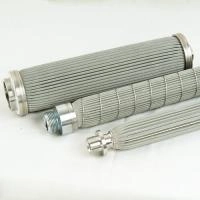
Oil Gas Water Filter
The series of particulate containment methods provides a reliable filtration efficiency along with continuous fluid clarity.
Also, it exhibits great dirt-holding properties.
FilSon oil gas water filter is specially manufactured to eliminate clogging and folding with its excellence filtering material.
The filter media compacted for effective fluid filtration.
It can serve in a wide range of industrial applications.
Lube Oil Filter
Most engines like automotive and generator engines, industrial equipment and machines are designed with lubrication systems.
The lubrication systems are usually fitted with lube oil filters that make them operate reliably at optimum performance specification.
The following are various types of lube oil filter from FilSon Filters that will help you address lube oil filtration problems:
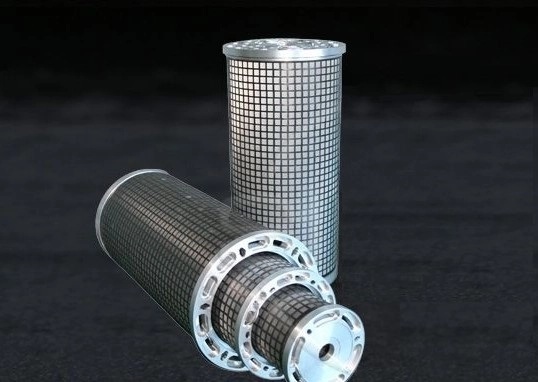
Lube oil filter
· Lubricant System Oil Filter
Generally, a lubricant oil filter system has a robust ergonomically design that provides compact structure for protecting the lube filter element from cracking.
Considering the nature of its application, it is slightly sturdier as compared to hydraulic oil filters.
The structure is highly resistant to pressure because it usually placed just after the lube pump and acts as the last protection line to critical system components.
· Multi-lube Filter
FilSon multi-lube Filter is a special design for heavy application.
It works in a number of ways as dual-line, single-line or progressive lubrication-system.
By the way, it is compatible with both grease and oil and highly durable due its compact structure design.
In most cases, it is connected to a fluid reservoir to maintain a reliable lubrication process.
FilSon Filters designs multi-lube filter to accommodate some extra external components besides auxiliary structures like piston pump, pressure relief-valve.
· Stainless Steel Lube Oil Filter
FilSon stainless-steel lube oil filter has a great dirt-retention capacity, which makes it suitable for outdoor marine, off-shore and corrosive environment applications.
This type of lube oil filter has a compact, rigid and strong structural design with the firmly held filter media.
It has an unquestionable structural integrity.
FilSon stainless-steel lube oil filter guarantees a reliable and filtration stability during circulation of the operating oil.
· Truck Oil Filter
Truck oil filter from FilSon Filters provides the top-notch performance, resilience and reliability for automotive engine system.
It is designed to offer comprehensive oil filtration for your truck.
This is because of a robust filter element which handles high oil particulate while maximizing fluid flow.
Furthermore, it exceeds OEM specification since it can hold up to 300% more particulates.
The truck oil filter has:
- High heat resistance
- Unquestionable structural integrity
- Filters both conventional and synthetic motor oils.
Its housing structure does it have a greater resistance to burst.
· Car Engine Oil Filter
FilSon car engine oil filter has a more sophisticated filtration efficiency that offers protection against wear down abrasive.
It has a pleated filter surface which increases surface area for maximum oil filtration.
The filter media structure design helps promote the free oil flow
Of course, this is due to the fact that filter material offers low fluid flow restriction.
FilSon car engine oil filter has its media reinforced making it have a steady and reliable performance throughout its operation.
The car engine oil filter is capable of sustaining air flow to optimize the engine performance.
Equally, it exhibits a greater particulate holding capacity allowing for longer oil drain intervals like truck oil filter.
· Stainless Steel Metal Sintered Filter Cylinder
The porous metal feature attracts a number of industrial applications.
Stainless steel metal, sintered filter cylinder by Filson Filter has pleated filter element.
It is this element that increases surface area for fluid contact as much as filtration.
Because of mesh laminate or sintered fiber, you can achieve a depth filtration mechanism.
In fact, the sintered fiber promotes refined filtration, improved permeability and increased dirt-holding capacity.
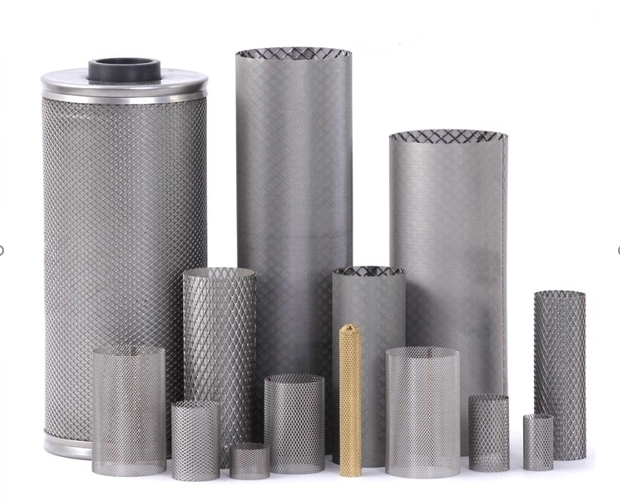
Stainless steel metal sintered
The filter element is easily re-cleanable and flushable.
Its multiple layer permits innumerable cleaning cycles and element endurance.
It is simply a reusable filter element.
Stainless steel metal sintered filter cylinder can be deployed in extremely high temperatures form -50 0C to 600 0C.
It has great resistance to corrosion and differential pressures.
It has a variety of industrial applications like in chemical processing, food & beverage, nuclear & energy, pharmaceutical and water treatment.
· High Pressure Oil Filter
Here, we have a couple items with specific application as the name suggests:
- HDX High Pressure Filter

HDX High Pressure Filter
Generally, its filter element is made of glass fiber that is specially designed to efficiently capture oil particulates at extreme pressure levels.
It can attain 10µm filtration accuracy.
- Heavy Machinery High Pressure Oil Filter
As the name suggests, FilSon Filters has a variety of heavy machinery, high pressure oil filters that are specifically designed for most heavy duty applications.
The filter media is made of strong material, hence durable.
It can produce a vast range of cleanliness ratings as well as operate at high pressure environment (120 bar).
Its porosity promotes a fair flow rate range.
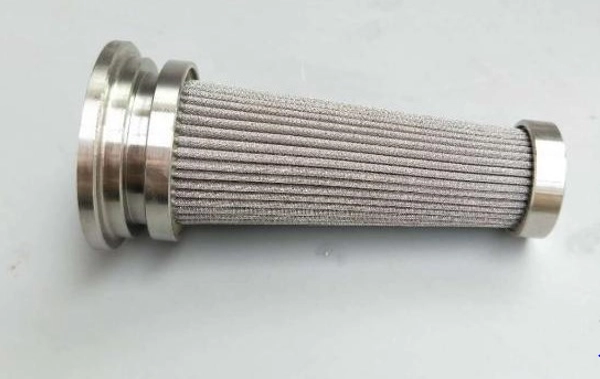
Heavy Machinery High Pressure Oil Filter
It comes with a strong structural integrity and can also combine a number of filter media materials.
Good examples include natural fiber cellulose and stainless steel wire-mesh.
- High Pressure FilSon Oil Filter Element
High pressure FilSon oil filter element has greater system reliability in terms of filtration.
Its premium dirt-retention capacity assures long element service life.
This product can also achieve excellence cleanliness level.
This is why it guarantees longer maintenance intervals.
Generally, it can sustain a stable differential pressure across the filter media.
Therefore, the high pressure FilSon oil element can provide greater safety while in operation.
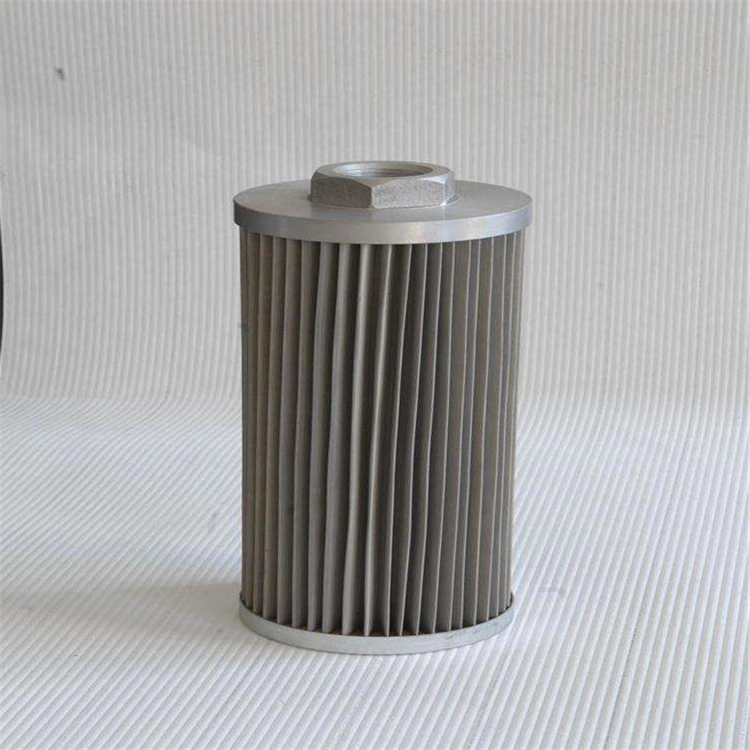
High Pressure FilSon Oil Filter Element
- High Pressure Hydraulic Oil Filter
High pressure hydraulic oil filter from FilSon Filters can accommodate various ranges of medium and colloidal materials.
The filter element material is made of fiberglass that enhance and improves filtration efficiency.
It can operate under a fair temperature range of -30°C to 100°C and achieve selectable filtration accuracy.
Compact structure contributes to its great rigidity while a series of combined layers:
- Microfiber layer
- Pre-filtration layer
- Support layer
- Gravity
- Sedimentation layers
All these layers refine the fluid filtration process.
It is also designed to control pollution while under operation.
High Flow Oil Filter
High Flow Oil Filters are basically designed to operate under high flow rate in a hydraulic system.
Below are some examples with great features:
- High Flow Hydraulic Filter
- Filson Oil Filter
The FilSon oil filter material is made up of micro-glass fiber, which has the ability to capture 400% more oil particulates unlike cellulose filter media.
Still, the filter media inherent features such as glass-fiber density, uniform pore size and shape ensure outstanding filtration accuracy.
Also, it has a wide operation pressure range of about 21-210 bars with a fair temperature range of between -10°C to 100°C.
Ultimately, these promote long service life of the fluid.
- FilSon Hydraulic Filter
FilSon hydraulic filter for high flow oil filtration offers protection to system components while providing continuous and consistent filtration processes.
Of course, this is due to the high quality filter element material.
It rapidly attains and maintains the required cleanliness level.
Besides, it is compatible with a vast range of fluids like water-oil emulsion, petroleum oils, lubrication and synthetic hydraulic fluids.
Basket Filter Element
Most of its filter media is available in different forms like in carbon steel, special alloys, stainless steel and others depending on the application.
Basket filter element best suits larger flow rates.
It has a fairly big diameter, compact and robust structural design.
This enables it to work in extreme pressure and temperature conditions.
The basket filter element is also available in both horizontal and vertical design.
Also available is an alternative with an adjustable micron rating by basket change or mesh arrangement.
It is also reinforced with strainers, which hold and accumulate dirt and particles.
However, it can be removed easily.
In short, these are some of the most common hydraulic filter systems from FilSon Filters.
At any given point, it is important to note the following:
Prevent oil contamination by all means – I am sure you now know the devastating effects of different types of contaminants.
At least you know FilSon Filters offers genuine and premium oil filter elements—it is exactly where you need to source for oil filter elements.
Up to this point, I believe you are now more informed than when we started.
Now it’s your turn – are you looking for an oil filter element?
Or, do you have any questions about hydraulic oil filtration systems.
Talk to us by leaving a quick comment below.
Also, feel free to share this article with your friends so that they may also learn more on oil filter elements.

